
|

|
| | | | 8/31-
2a 9/5 Labor Day 9/28 Exam 1 10/17
- 9b - last day for
paper 1 rewrites 10/31 Review | | 11/2 Exam 2 11/14
- 16a 11/23 No Class 12/5 Exam 3 12/7 Review 12/12- Final Exam
- Optional Exam 3 retake: 12/14
UNITS AND LESSONS -
ASSIGNMENTS:
- Syllabus Quiz
- last day for paper 2 rewrite
- last day for paper 3 rewrite
- 1:45-3:30 J253
-Study
Guide
9:55-11:40 J253
Optional Exam 3 retake:
1:45-3:30 J253 -
Unit 1: ECONOMICS and GLOBALIZATION
|
Unit 2: INTRO. TO MACROECONOMICS |
Unit 3: MACROECONOMIC POLICY |
|
1a Introduction |
|
Welcome to ECO 212! This course will cover the area of economics commonly defined as macroeconomics. The main goal of macroeconomics is to gain a better understanding of the causes of, and remedies for, UNEMPLOYMENT and INFLATION, as well as the factors that affect ECONOMIC GROWTH. We will also discuss the two types of economic growth, what I like to call "ACHIEVING THE POTENTIAL" and "INCREASING THE POTENTIAL". Please buy the textbook as soon as possible. If you buy your textbook online, order it today. See the syllabus for the correct textbook. The textbook should cost less than $30 if you buy it online. While you wait for your textbook to arrive there is still some work that you can do. To begin, I suggest you do the following: - read the syllabus Email me or use the Blackboard Discussion Board if you have questions. Many students end up dropping or failing this course due to the lack of basic math skills. If your math skills are weak you should consider building them before taking this course. If you are required to take MTH 060 or MTH 082 and have not yet done so, do not take this economics course until you have successfully completed one of them. I have posted a math quiz on our Blackboard site. Take the math quiz on Blackboard. If you score less then 14 or 15, consider dropping ECO 212 and taking a math class first. Good luck and start studying. |
1a Something Interesting - Why are we studying this? |
|
Optional: a funny look at some major ideas of economics by the Stand-up Economist. Principles
of economics, translated *NOTE: There will be a short case study for most lessons ("Something Interesting - Why are we studying this?"). The case study does not include everything from the lesson but it will highlight an interesting and important topic. The case studies are meant to grab your attention and help you APPLY a concept from the lesson to a real world issue. At first the case study may not make sense. In fact, many will appear contrary to common sense, (like why are high prices GOOD for the people suffering from a natural disaster), but after finishing the lesson you should have a better understanding of the case study or ask for help in class or on the Blackboard discussion board. |
1a Assignments: Readings |
|
Read: Syllabus Ch 1, pp.1-7 Ch.1, Appendix on Graphing Buy the textbook -- see the syllabus Buy the Videos: -- see the syllabus |
1a Assignments: Video Lectures |
|
WHAT IS ECONOMICS: THE STUDY OF SCARCITY
REVIEW OF GRAPHING CONCEPTS
OPTIONAL:
|
1a Outcomes - What you should learn |
|
TOPICS
OUTCOMES
|
1a Key Terms |
|
Key Terms Flash Cards - Class Activities - Click Here Key Terms Flash Cards - What is Economics? - Click Here Key Terms Flash Cards - Math - Click Here Key Terms: CLASS ACTIVITIES: Pre-quiz, Clicker Quiz, Required Activity, Yellow Pages, Tomlinson Videos on Thinkwell, Video Notes, Practice Exercises, LESSONS webpage, |
1a Practice Quiz (under construction) |
1a Formulas |
|
Slope = rise/run Slope = vertical change / horizontal change Slope = marginal value of the total |
1a Key Graphs |
|
Any Point on a Graph Represents Two Numbers Direct Relationship Inverse Relationship Calculating Slope |
1a Review Videos |
|
Episode
5A: Models & Theories Episode
6: Graph Review NOTE: These are REVIEW videos only. In order to learn the material you must read the assigned textbook readings, watch the assigned lecture videos, and do problems. See the LESSONS link on Blackboard for these assignments. |
|
1b Introduction |
|
The "5Es of Economics" are not from the textbook. I borrowed the concept (with many modifications) from another textbook many years ago. I believe it concisely explains the purpose of economics. Also, it begins to introduce students to the economic way of thinking. The economic problem that we all face, that all countries face, that the world faces, is SCARCITY. Economics is the study of how we can reduce scarcity. What I like about the 5Es model is that it shows us that there are only five ways to reduce scarcity. Only five. I call them the "5Es" of economics. For each of the 5Es: (1) learn the definition, This is where you learn that it may be good when the price of plywood increases greatly as the result of a hurricane. And why it might be good when Coca-Cola lays of one fifth of its workforce. Or, that the price of gasoline may be too low. Really! In this MACROeconomics course we will focus on Economic Growth and Full Employment. Efficiency, efficiency, and equity are the focus of my MICROeconomics classes and few economists study "Reducing Wants". The overall goal of economics is to REDUCE the SCARCITY of goods and services. Economic growth and full employment are two (of five) ways to do this. Pay close attention to the new definition of economic growth presented in the online reading. It is different from what you might hear in a news report. Also, pay attention to HOW such economic growth is achieved: - finding more resources, This type of economic growth involves INCREASING THE POTENTIAL of the economy to produce goods and services. Full employment helps an economy ACHIEVE ITS POTENTIAL by using all of its resources. Again, notice the slightly different definition than is commonly used for full employment. We are not just talking about labor, but ALL available resources. There are three issues that macroeconomics studies: (1) unemployment - UE, (2) inflation - IN, and (3) economic growth - EG, (UE, IN, and EG).
|
1b Something Interesting - Why are we studying this?* |
|
When a hurricane hits the coast of Florida, prices of many necessities like food, water, hotel rooms, gasoline, and even plywood, tend to increase. Some governments try to prevent such price increases and call them "price-gouging". See: http://www.csmonitor.com/1992/0910/10083.html But economists think that such price increases are GOOD for the people ravaged by the hurricane. WHY? Why is it GOOD when the prices of products (like plywood) increase during a natural disaster? See: https://www.masterresource.org/price-gouging-law/defense-price-gouging/ ANSWER: Allocative Efficiency *NOTE: There will be a short case study for each lesson. The case study does not include everything from the lesson but it will highlight an interesting and important topic. The case studies are meant to grab your attention and help you APPLY a concept from the lesson to a real world issue. At first the case study may not make sense. In fact, many will appear contrary to common sense, (like why are high prices GOOD for the people suffering from a natural disaster), but after finishing the lesson you should have a better understanding of the case study or ask for help in class or on the Blackboard discussion board. |
1b Assignments: Readings |
|
The 5Es of Economics (VERY IMPORTANT!) Ch. 3: "Efficient Allocation" pp. 58-59 Ch. 3 "Diminishing Marginal Utility" pp. 49 and 117 Ch.1, Appendix on Graphing |
1b Assignments: Video Lectures |
|
Macroeconomics Unit 1 Intro: Basic Economic Concepts (AP Macro) (YouTube ACDCLeadership 1:38) [MyNotes] Scarcity and Exchange - EconMovies #1: Star Wars (YouTube ACDCLeadership 6:39) |
1b Outcomes - What you should learn |
|
TOPICS
OUTCOMES
|
1b Key Terms |
|
Key Terms Flash Cards - Click Here Key Terms: scarcity, economic growth, allocative efficiency, productive efficiency, equity, full employment, marginal, law of diminishing marginal utility, President Obama example |
1b Practice Quiz (under construction) |
1b Key Figures / Graphs |
|
The 5Es of Economics |
1b Review Videos |
|
What
Is Economics? |
In the 5Es lesson we learned
that economics is about making choices. Choices are
forced upon us as a result of scarcity. Here we
will study a graphical model, the Production
Possibilities Curve (PPC) that shows us that we
MUST MAKE choices and it highlights some of the
consequences of making choices. Then we will look
at HOW to make good choices by using Benefit Cost
Analysis (BCA). The production possibilities
curve will show us that all decisions have costs.
Economists call these "opportunity costs". ALL
COSTS IN ECONOMICS ARE OPPORTUNITY COSTS. Whenever
we discuss the "costs" of doing something we will
mean the complete opportunity
cost. What is the connection
between the PPC and BCA? Well, when studying the
PPC you will learn the important concept of
"opportunity cost". Learn the definition well.
Since all costs in economics are opportunity costs,
then when using BCA, "marginal costs" means the
additional opportunity costs. Also, since economic growth
is one of the three macroeconomic issues. We will
use the PPC to demonstrate the two types of
"economic growth": Achieving the potential is
caused by reducing unemployment or achieving
productive efficiency. On the graph it is moving
from a point inside the PPC to a point on the SAME
CURVE. Increasing the potential, or what we will
call economic growth, is shown on the PPC as the
whole curve shifting out to a NEW CURVE. We will
see this again in chapter 8. Why would airbags in cars
cause more accidents (see the link below)? After
studying this lesson you should be able to use
Benefit Cost Analysis (MB=MC) to answer this
question. A similar question for skiers
is why did the invention of avalanche airbags cause
more people to become caught in avalanches (see
below)? After studying this lesson you should be
able to use Benefit Cost Analysis (MB=MC) to answer
this question. What are avalanche
airbags? Ch 1: Production
Possibilities Model, pp. 11-21 Ch. 1: p. 5, "Marginal
Analysis: Benefits and Costs" Ch. 1: pp. 13-14, "Optimal
Allocation" (especially Fig 1.3), Drivers
with airbags may take more risks Ch 1: p. 14, "The Economics
of War" (box) PRODUCTION
POSSIBILITIES 1.4.2
Understanding
How a Change in Technology Affects the
PPF 10:10
[MyNotes] MAKING
CHOICES: THE ECONOMIC WAY OF THINKING --
BENEFIT-COST ANALYSIS (also called Marginal
Analysis or Cost-Benefit Analysis) Thinking
at the Margin
(YouTube LearnLiberty 4:32)
[MyNotes] Incentives
and Marginal Analysis
(YouTube MrHurdleHistory 8:54)
[MyNotes] OTHER ECONMOVIES
Episode 3: Monsters Inc. and the Production
Possibilities Curve TOPICS OUTCOMES Production
Possibilities Benefit Cost
Analysis Key
Terms Flash Cards - Click Here Key Terms: production possibilities,
necessity of choice, law of increasing costs,
concave to the origin, opportunity cost,
constant cost, benefit cost analysis (marginal
analysis), economic growth, consumer goods,
capital goods, shrinking PPC, nonproportional
growth BCA: marginal costs (MC),
marginal benefits (MB), MB=MC Rule, sunk (fixed)
costs MB = MC MB = change in Total Benefits
/ change in Quantity MB = MC = change in Total Costs /
change in Quantity MC = Notice that I will use a
triangle ( Production Possibilities
Schedule and Curve PPC: Achieving Full
Employment and Achieving Productive Efficiency PPC: Economic Growth
(Increasing the Potential) Benefit Cost
Analysis - Production
Possibilities Curve- Econ 1.1 - Shifting
the Production Possibilities Curve (PPC)- Econ
1.2 NOTE: These are REVIEW videos
only. In order to learn the material you must read
the assigned textbook readings, watch the assigned
lecture videos, and do problems. See the LESSONS
link on Blackboard for these
assignments. Because of scarcity we must
make choices. An "economic system" is the way that
societies make economic choices. Because of
scarcity all countries must decide (1) what to
produce, (2) how to produce, and (3) who get what
is being produced. Economic systems answer these
fundamental questions. All over the world economies
are undergoing a process that I like to call
"structural adjustment", but it is more commonly
called "globalization". That is, countries are
moving away from a command economy with government
central planning to a laissez-faire market economy
or capitalism. In this process the economic role of
government is decreasing all over the world (well,
almost). In order to understand why
this is happening we have to study unit 1, chapters
1, 2, 3 and 20, which are really MICROeconomic
chapters. Strangely our Tomlinson videos do not
discuss in depth the characteristics of market
economies but our textbook does (chapter 2). Our
textbook does not spend much time discussing
command economies (planned economies), or economies
in transition from planned to market (from command
to capitalism), but the video lectures do!
When studying chapter 2, both
the textbook and the videos, try to understand the
following: (1) What are the characteristics of
market and command economies? (2) What are their
benefits and problems? and, (3) Why are countries
moving away from a command economy toward a market
economy? In lesson 2a we will examine
those questions. Then, in lesson 2b, we will look
at what the role of government should play in a
market economy. All over the world the economic
role of government is decreasing, but it is not
disappearing. So, what IS the economic role of
government in market economies? Structural adjustment, or
globalization, has helped take nearly 1 billion
people out of extreme poverty in 20 years. How?
Read the short article below. In the fifth paragraph the
article says: "Most of the credit [for
poverty reduction in the last twenty years]
must go to capitalism and free trade, for they
enable economies to grow - and it was growth
principally that eased destitution." Online - Cuba
Examines Asian Model For Economic
Reforms
(NPR Morning Edition) Textbook: Ch. 2 Last Word:
"Shuffling the Deck": p. 42 Ch. 8 The Last Word -
"Economic Growth in China": p. 166 Ch. 8 Global Competition,
p. 164 Chapter 23W of the 16th
edition of our textbook, pages 2-13, found on
our Blackboard site ECONOMIC SYSTEMS 1.1.4
An
Overview of Economic
Systems 10:50
[MyNotes] Power
of the Market
(YouTube LibertyPen) 1:14 [MyNotes] 1.1.5
Case
Study: The Work of Adam
Smith 8:57
[MyNotes] TRANSITION
ECONOMIES 17.5.2
Policies
to Change to Market
Systems 11:18
[MyNotes] 17.5.3
Comparative
Economic Performance
12:16 [MyNotes] OPTIONAL
(but interesting) Paul
Solman Video: Capitalism vs. Socialism - The
Cuban Quandary
(YouTube PBS NewsHour) 13:56 Scroll down
to: 10. Developing
Countries Click on
Then slide the
timer to minute 7:45 for the eight
minute South Korea vs. Sri Lanka
case study Scroll down
to: 11. Economies in
Transition Click on
Then slide the
timer to minute 27:25 for the eight
minute the success of Poland’s
“shock therapy case
study TOPICS OUTCOMES Key
Terms Flash Cards - Click Here Key Terms: World Decrease in Poverty -
mostly caused by Structural Adjustment Circular Flow
Model - Econ
1.6- Economic Systems: Why is Communist China doing
so well? NOTE: These are REVIEW videos
only. In order to learn the material you must read
the assigned textbook readings, watch the assigned
lecture videos, and do problems. See the LESSONS
link on Blackboard for these assignments.
![]()
1c Introduction
- an economy
ACHIEVING ITS POTENTIAL
- and an economy INCREASING ITS POTENTIAL
1c Something Interesting -
Why are we studying this?
Drivers
with airbags may take more risks
In a
March
2013 blog post
written by Utah Avalanche Center Director Bruce
Tremper . . . Tremper says airbags are providing
a false sense of security, leading more skiers
into high-consequence terrain, and thus
decreasing the effectiveness of said
airbag.
"Each gizmo we
buy to increase our safety usually cause us
to increase our level of risk at the same
time. For instance, when we added seat belts
and airbags to cars, yes fatalities
decreased, but it also allowed us to drive
faster, farther, crazier and talk on our
mobile phones at the same time. So safety
measures usually work but not nearly as well
as we would hope because people just increase
their risk (and “utility”) at the
same time. In avalanche airbag case, we will
also get more powder, more fun, and more risk
in the bargain . . . . people will increase
their exposure to risk because of the
perception of increased safety, which will
cancel out some, but not all, of the
effectiveness of avalanche airbag"
https://www.youtube.com/watch?v=h7QFRXc0R8M
1c Assignments:
Readings
1c Assignments: Video
Lectures
1.4.1
Understanding
the Concept of Production Possibilities
Frontiers 24:46
[MyNotes]
EconMovies-
Episode 2: Monty Python and the Holy Grail -
Marginal Analysis
(YouTube ACDCLeadership 5:27)
Micro
1.1 The BIG Picture- AP Economics Overview (with
links to playlists)
(YouTube ACDCLeadership 12:49)
1c Outcomes - What you
should learn
1c Key Terms
PPC:
1c Practice Quiz (under
construction)
1c Formulas
![]() TB
/
TB
/ ![]() Q
Q![]() TC
/
TC
/ ![]() Q
Q![]() )
to mean "change in"
)
to mean "change in"
1c Key Graphs
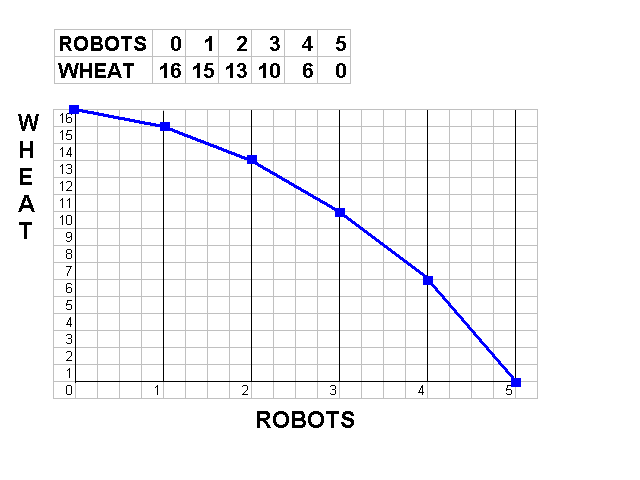
(Achieving the Potential)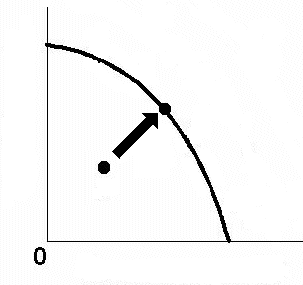
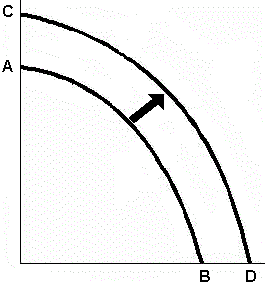

1c Review Videos
[3:56 YouTube ACDC
Leadership]
[5:35 YouTube ACDC Leadership]
![]()
2a Introduction

2a Something Interesting -
Why are we studying this?
http://www.economist.com/news/leaders/21578665-nearly-1-billion-people-have-been-taken-out-extreme-poverty-20-years-world-should-aim/
2a Assignments:
Readings
- A
Comparison of Command Economies and Market
Economies
Chapter 2 ALL
- State Ownership
and Central Planning: pp. 23W-2 to 23W-3
- Problems with
Central Planning pp. 23W-3 to 23W-5
- The Collapse of
the Soviet Economy pp. 23W-5 to 23W-6
- The Russian
Transition to a Market System pp. 23W-6 to
23W-9
- Market Reforms in
China pp. 23W-10 to 23W-11
- Outcome and
Prospects pp. 23W-11 to 23W-13
- Conclusion pp.
23W-13
2a Assignments: Video
Lectures
10.1.2
The
Circular Flow Model
9:38 [MyNotes]
17.5.1
Centrally
Planned Economies
10:57 [MyNotes]
Case Study:
South Korea vs. Sri Lanka:
[MyNotes]
Click
on: http://www.learner.org/resources/series86.html
![]() (you may have to click on
(you may have to click on ![]() twice)
twice)
Case Study:
Poland [MyNotes]
Click
on: http://www.learner.org/resources/series86.html
![]() (you may have to click on
(you may have to click on ![]() twice)
twice)
2a Outcomes - What you
should learn
2a Key Terms
structural
adjustment, economic system, command system
(centrally planned, socialism, command economy),
market system (captialism, laissez-faire, market
economy), mixed economic system, Bolshevik
revolution, self interest, private property,
freedom of enterprise and choice, competition,
market, specialization, consumer sovereignty,
dollar votes, invisible hand, creative
destruction, coordination problem, incentive
problem, circular flow diagram, product market,
resource market, privatization, nationalization,
central planning, shock therapy, import
substitution
2a Practice Quiz (under
construction)
2a Key Graphs

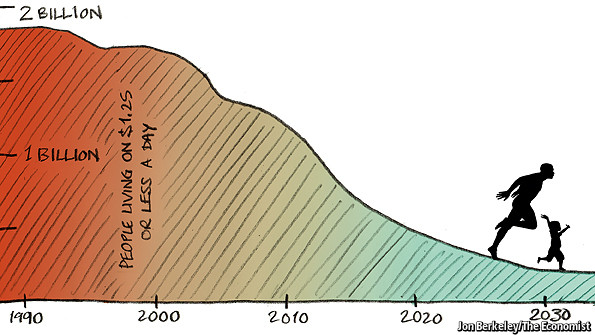
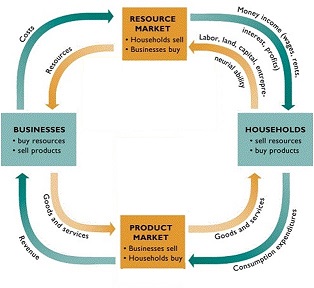
2a Review Videos
[4:13 YouTube ACDC Leadership]
Now, you should have a good
idea of the characteristics, benefits, and problems
of the two main types of economic systems and
understand how, and why, countries seem to be
moving toward a market, or more laissez-faire,
system. Here we will examine the economic functions
of government in a market economy. Most economists, and
politicians, agree on these general principles, BUT
they may disagree strongly on the degree of
involvement the government should have in the
economy. I think, most people agree on WHAT the
government should do, but they disagree on HOW
MUCH. We learned in lesson 2a that
market economies are efficient and that centrally
(government) planned command economies are
inefficient. So whenever there is government
involvement in a market economy we should ask WHY?
If market economies are efficient and efficiency
reduces scarcity, why would the government get
involved? We will learn that sometimes the
government is needed to ASSIST a market economy to
be efficient and sometimes a market economy is
inefficient and the government is needed to FIX
it. After looking at the economic
functions of government we will look at government
finance in the United States. Latter in this course
we will discuss how the goverment uses spending and
taxation to affect the economy. Here we learn what
the government spends its money on and where
governments get their revenue (taxes). Skim the news articles below
about raising taxes on gasoline and putting taxes
on soda and junk food. After studying this lesson
you should understand why many people support these
taxes. Why
might gasoline prices be too low? Why
are several cities and states considering a tax on
sodas? http://www.sfgate.com/bayarea/article/Tax-on-soda-to-be-floated-in-San-Francisco-4932025.php Why did Mexico tax junk
food and soda? Economic
Functions of Goverment Textbook pp. 99-101,
104-108 Microeconomics Chapter 16
(found on our Blackboard site): pp
338-346 Role
of Government in a Mixed
Economy (YouTube -
Daniel Mares15:53) [MyNotes] When
is a Potato Chip Not Just a Potato
Chip
(YouTube-LearnLiberty 4:46) Public
Goods and Asteroid
Protection
(MRUniversity 2:30) EconMovies
7: Anchorman (Efficiency and Market
Failures) A
Deeper Look at Public Goods
(MRUniversity 7:55) Where
do your tax dollars go?
(YouTube - Test Tube News 3:44) 8.2.2 Analyzing
the Tax System (8:19)
[MyNotes] OPTIONAL: Tax
Brackets and Progressive
Taxation Khan Academy
(4:14) TOPICS OUTCOMES Key
Terms Flash Cards - Role of Government - Click
Here Key
Terms Flash Cards - Government Finance - Click
Here Key Terms: Government
Finance: Average Tax Rate = taxes paid
/ income Marginal Tax Rate = change in
taxes paid / change in income Marginal Tax Rate =
Notice that I will use a
triangle ( Micro
Unit 6 Intro- Market Failures and the
Government NOTE: These are REVIEW videos
only. In order to learn the material you must read
the assigned textbook readings, watch the assigned
lecture videos, and do problems. See the LESSONS
link on Blackboard for these assignments.
![]()
2b Introduction
2b Something Interesting -
Why are we studying this?
http://www.npr.org/templates/story/story.php?storyId=4858826http://www.stltoday.com/news/local/illinois/buying-soft-drinks-in-illinois-would-cost-more-under-tax/article_5eccc299-6c48-5b44-9643-95bce5365dee.html
http://www.politico.com/story/2014/01/mexico-soda-tax-101645
2b Assignments:
Readings
- Government
Finance;
- Federal Finance;
- State and Local Finance;
- Local, State, and Federal Employment;
- Apportioning the Tax Burden;
- The VAT
2b Assignments: Video
Lectures
2b Outcomes - What you
should learn
or government purchases vs. government
spending,
2b Key Terms
Role of
Government:
consumer
sovereignty, monopoly, natural monopoly,
antitrust, transfer payments, market
intervention, market failure, negative
externality, positive externality, public
goods, private goods, rivalry, nonrival,
excludability, nonexcludability, free-rider
problem, macroeconomic stability, fiscal
policy, monetary policy, expansionary fiscal
policy, easy money policy, contractionary
fiscal policy, tight money policy,
government
purchases, exhaustive, transfer payment,
nonexhaustive, deficit spending, personal
income tax, payroll tax, benefits received
principle, ability-to-pay principle, average
tax rates, marginal tax rates, progressive
tax, proportional tax, regressive tax, value
added tax (VAT)
2b Practice Quiz (under
construction)
2b Formulas
![]() taxes /
taxes / ![]() income
income![]() )
to signify "change in"
)
to signify "change in"
2b Review Videos
[2:31 YouTube ACDC
Leadership]
If the price of pizza goes
up, what happens to the demand for pizza?
. . . . . . . .
. . . . . . . . . . . . . . . . . . . . . .
The next three lessons
introduce the demand and supply model for
explaining how prices arise and change in a market
economy. Learn these lessons well. Do the assigned
problems. Draw the graphs in the Yellow Pages and
while you are reading and studying. DRAW GRAPHS!
Get used to using the graphs to help you answer
questions. If you are avoiding drawing the graphs
you will do poorly and not get the practice that
you need to learn the concept. So why doesn't the demand for
pizza change if the price changes? Because
economists have a different definition of "demand".
Demand is NOT the quantity that we buy. If the
price of pizza goes up we will buy less, but that
is not what "demand" means in economics.
Economists tend to be precise
with their definitions and sometimes their
definitions are different than the more commonly
used definitions. Things like "scarcity",
"investment", "cost", "demand", and "supply", have
different definitions in economics than what you
may already know. Learn our definitions!
Demand is not how much we buy. Demand has a
different definition in economics. "Demand" means
the "demand graph". Economists use models (like
the supply and demand model) to simplify the real
world. They do this by isolating certain variables
from all the clutter found in reality. Then by
changing one variable at a time economists can see
what effect it will have. In this lesson we will learn
the economic definition of DEMAND and plot the
demand graph. Then, we will look at one variable at
a time to see what effect they have on the demand
curve. We call these variables the "non-price
determinants of demand". They are: Pe, Pog, I,
Npot, T or "PPINT". LEARN THEM! LEARN THEM WELL!
Know how each one affects the demand curve. Be sure
to do the Yellow Pages and other Practice
Activities until you understand the concept
well. See the picture below.
VanCamp's Pork and Beans are on sale (price is
lower). Notice that there is a can of Campbell's
Pork and Beans on the sale display. What is that Campbell's Pork
and Beans can doing on the display for VanCamp's
Pork and Beans? After studying this lesson
you will be able to draw a graph illustrating what
happened to the demand for Campbell's Pork and
Beans when a customer took a can out of their
shopping cart and placed it on this display of
VanCamp's beans that were on sale. Ch 3, pp. 47-53 2.1.1
Understanding
the Determinants of Demand
11:58 [MyNotes] 2.1.2
Understanding
the Basics of Demand
11:54 [MyNotes] 2.1.3
Analyzing
Shifts in the Demand Curve
8:13 [MyNotes] 2.1.4
Changing
Other Demand Variables
10:43 [MyNotes] 2.1.5
Deriving
a Market Demand Curve
9:16 [MyNotes] OPTIONAL: Linear
Demand Equations -- Shifts in
Demand
(econclassroom.com 14:16) Econ
2.1 Demand and Supply Explained (1 of 2)
(6:42) The
Determinants of Demand
(10:25) TOPICS OUTCOMES Non-Price Determinants of
Demand (PPINT) I -- income N -- number of POTENTIAL
consumers Non-Price Determinants of
Supply (PPPTTN) NON-PRICE DETERMINANTS OF
DEMAND Pe -- expected
price Pog -- price of other
goods 2) complementary goods I -- income 2) inferior goods Npot -- number of
POTENTIAL consumers T -- tastes and
preferences NON-PRICE DETERMINANTS OF
SUPPLY Pe -- expected
price Pog -- price of other
goods also produced by the same firm Pres -- price of
resources Tech
--technology Tax --taxes and
subsidies N -- number of
producers/sellers Key
Terms Flash Cards - Click Here Key Terms: Demand Schedule and
Curve Change in Quantity
Demanded Change in Demand:
Increase Change in Demand:
Decrease Market Demand - Demand
and Supply Explained- Econ
2.1 NOTE: These are REVIEW videos
only. In order to learn the material you must read
the assigned textbook readings, watch the assigned
lecture videos, and do problems. See the LESSONS
link on Blackboard for these
assignments. If the price of pizza goes up
what happens to the SUPPLY of pizza? NOTHING!
A change in the price of a
product does not affect its supply, or its demand.
When the price goes up the QUANTITY SUPPLIED will
increase, but the supply does not change. Learn the
difference between "supply" and "quantity
supplied". "Supply" does NOT MEAN the quantity
available for sale. Supply has a different
definition in economics. "Supply" means the "Supply
graph". So what would cause the
supply graph, or supply itself, to change? Those
things that cause supply to change are called the
"non-price determinants of supply". They are: Pe,
Pog, Pres, Tech, Tax, Nprod or "PPPTTN". See the
Yellow Pages. Remember, the goal of chapter
3 is to learn a model that will help us understand
why prices are what they are and why they change.
In the next lesson we will put demand and supply
together and use the model (graph) to find the
prices of products. Then, and more importantly, we
will see what causes prices to change. After completing this
chapter, if you hear on the news, or read in your
news app, that the price of gasoline is going down,
we will be able to explain WHY. The causes of
changes in prices of products are the five
non-price determinants of demand (Pe, Pog, I, Npot,
T) and/or the six non-price determinants of supply
(Pe, Pog, Pres, Tech, Tax, Nprod.). Whenever you
hear that the price of something is changing think
of these 11 possible causes. Read the short news article
below on the declining price of gasoline (Dec.
2015). Paragraph 10 states "Plunging oil prices are
the main factor driving down the price at the pump.
" After studying this lesson
you should be able to (1) list the non-price
determinants of supply, (2) select the determinant
that is the cause of the decline in gasoline prices
discussed in the news article above, and (3) graph
the effect that the change in the determinant will
have on the supply curve for gasoline. Ch3, pp. 53-56 Where
Is All That Excess Oil
Going? 2.2.1
Understanding
the Determinants of Supply
7:25 [MyNotes] 2.2.2
Deriving
a Supply Curve 9:49
[MyNotes] 2.2.3
Understanding
a Change in Supply versus a Change in Quantity
Supplied 6:52
[MyNotes] 2.2.4
Analyzing
Changes in Other Supply
Variables 8:47
[MyNotes] 2.2.5
Deriving
a Market Supply Curve from Individual Supply
Curves 7:16
[MyNotes] OPTIONAL EP
AP
Macro-Economics - Determinants of
Supply
[YouTube - ExamPop] KA
Factors
affecting supply
(6:57) NOTE : It looks like the supply graph is
labelled "D", but that is just point D (A, B, C,
D) on the supply curve. TOPICS OUTCOMES "According
to the Lundberg Survey, the average price for
regular gasoline dropped 3.99 cents over the
three weeks up to July 11 to $3.6699 per
gallon. . . . Lundberg explained that the
average gasoline price continues to decrease
because refiners, enjoying the lower crude
oil prices in the market, are passing down
the savings to the consumers. " Non-Price Determinants of
Demand (PPINT) I -- income N -- number of POTENTIAL
consumers Non-Price Determinants of
Supply (PPPTTN) NON-PRICE DETERMINANTS OF
DEMAND Pe -- expected
price Pog -- price of other
goods 2) complementary goods I -- income 2) inferior goods Npot -- number of
POTENTIAL consumers T -- tastes and
preferences NON-PRICE DETERMINANTS OF
SUPPLY Pe -- expected
price Pog -- price of other
goods also produced by the same firm Pres -- price of
resources Tech
--technology Tax --taxes and
subsidies N -- number of
producers/sellers Key
Terms Flash Cards - Click Here Key Terms: Supply Table and
Curve Increase in Supply Decrease in Supply - Demand
and Supply Explained (2 of 2) - Econ
2.2 NOTE: These are REVIEW videos
only. In order to learn the material you must read
the assigned textbook readings, watch the assigned
lecture videos, and do problems. See the LESSONS
link on Blackboard for these
assignments.
![]()
3a Introduction
3a Something Interesting -
Why are we studying this?

3a Assignments:
Readings
3a Assignments: Video
Lectures
Linear
Demand Equations Part 1 with
exercises
(econclassroom.com 6:41)
3a Outcomes - What you
should learn
3a Non-Price Determinants of
Demand and Supply
Pe -- expected
price
Pog -- price of other goods
1) substitute
goods
2) complementary goods
3) independent goods1) normal
goods
2) inferior goods
T -- tastes and preferences Pe -- expected
price
Pog -- price of other goods produced by same
firm
Pres -- price of resources
T --technology
T --taxes and subsidies
N -- number of producers/sellers![]() Pe
in the future
Pe
in the future ![]()
![]() D today
D today
![]() Pe in the future
Pe in the future ![]()
![]() D today
D today1) substitute
goods
![]() P Maxwell House coffee
P Maxwell House coffee ![]()
![]() D Folgers coffee
D Folgers coffee
![]() P of one product
P of one product ![]()
![]() D of its substitute
D of its substitute
![]() P of wieners
P of wieners ![]()
![]() D of buns
D of buns
![]() P of one product
P of one product ![]()
![]() D of its compliment
D of its compliment1) normal goods
![]() Income
Income ![]()
![]() D for normal goods
D for normal goods
![]() Income
Income ![]()
![]() D for normal goods
D for normal goods
![]() Income
Income ![]()
![]() D for inferior goods
D for inferior goods
![]() Income
Income ![]()
![]() D for inferior goods
D for inferior goods![]() Npot
Npot ![]()
![]() D
D
![]() Npot
Npot ![]()
![]() D
D![]() Tastes for a product
Tastes for a product ![]()
![]() D for that product
D for that product
![]() Tastes for a product
Tastes for a product ![]()
![]() D for that product
D for that product ![]() Pe in the future
Pe in the future ![]()
![]() S today
S today
![]() Pe in the future
Pe in the future ![]()
![]() S today
S today![]() P soybeans
P soybeans ![]()
![]() S corn
S corn
![]() P soybeans
P soybeans ![]()
![]() S corn
S corn![]() worker's wages
worker's wages ![]()
![]() cost of making cars
cost of making cars ![]()
![]() S cars
S cars
![]() Pres
Pres ![]()
![]() costs
costs ![]()
![]() S
S
![]() Pres
Pres ![]()
![]() costs
costs ![]()
![]() S
SImproved technology
![]()
![]() costs
costs ![]()
![]() S
S![]() Taxes
Taxes ![]()
![]() costs
costs ![]()
![]() S
S
![]() Taxes
Taxes ![]()
![]() costs
costs ![]()
![]() S
S
![]() Subsidies
Subsidies ![]()
![]() costs
costs ![]()
![]() S
S
![]() Subsidies
Subsidies ![]()
![]() costs
costs ![]()
![]() S
S![]() Nproducers
Nproducers ![]()
![]() S
S
![]() Nproducers
Nproducers ![]()
![]() S
S
3a Key Terms
demand, quantity
demanded, law of demand, market demand,
horizontal summation, income effect, substituion
effect, diminishing marginal utility, change in
demand, change in quantity demanded, increase in
demand, decrease in demand, non-price
determinants of demand, normal good, inferior
good, substitute good, complementary good
(complement), independent goods
3a Practice Quiz (under
construction)
3a Key Graphs
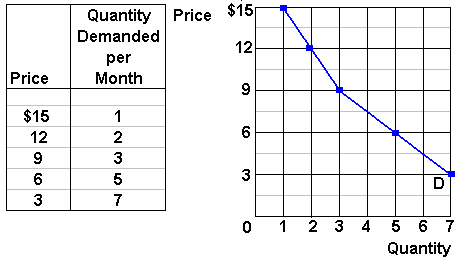
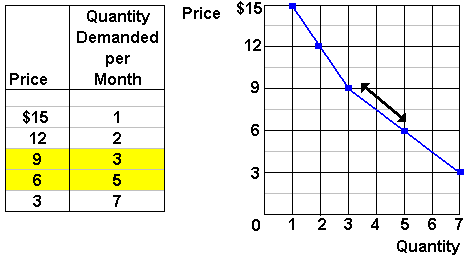
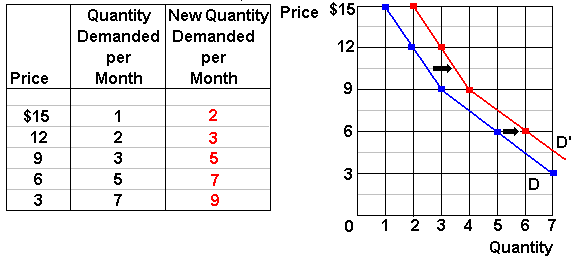
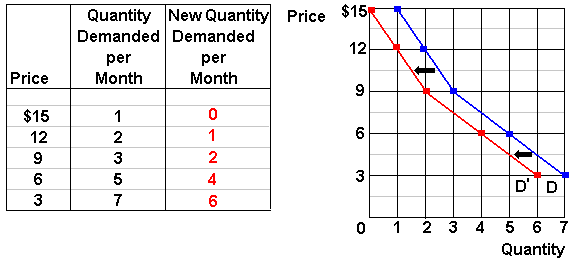

3a Review Videos
[6:20 YouTube ACDC Leadership]
![]()
3b Introduction
3b Something Interesting -
Why are we studying this?
3b Assignments:
Readings
[Why are they storing oil? What is happening to
supply? Which determinant has caused the supply to
change?]
3b Assignments: Video
Lectures
AC Econ
2.2 Demand and Supply Explained (2 of
2) (4:54 but just
watch up to 2:45)

3b Outcomes - What you
should learn
3b Non-Price Determinants of
Demand and Supply
Pe -- expected
price
Pog -- price of other goods
1) substitute
goods
2) complementary goods
3) independent goods1) normal
goods
2) inferior goods
T -- tastes and preferences Pe -- expected
price
Pog -- price of other goods produced by same
firm
Pres -- price of resources
T --technology
T --taxes and subsidies
N -- number of producers/sellers![]() Pe
in the future
Pe
in the future ![]()
![]() D today
D today
![]() Pe in the future
Pe in the future ![]()
![]() D today
D today1) substitute
goods
![]() P Maxwell House coffee
P Maxwell House coffee ![]()
![]() D Folgers coffee
D Folgers coffee
![]() P of one product
P of one product ![]()
![]() D of its substitute
D of its substitute
![]() P of wieners
P of wieners ![]()
![]() D of buns
D of buns
![]() P of one product
P of one product ![]()
![]() D of its compliment
D of its compliment1) normal goods
![]() Income
Income ![]()
![]() D for normal goods
D for normal goods
![]() Income
Income ![]()
![]() D for normal goods
D for normal goods
![]() Income
Income ![]()
![]() D for inferior goods
D for inferior goods
![]() Income
Income ![]()
![]() D for inferior goods
D for inferior goods![]() Npot
Npot ![]()
![]() D
D
![]() Npot
Npot ![]()
![]() D
D![]() Tastes for a product
Tastes for a product ![]()
![]() D for that product
D for that product
![]() Tastes for a product
Tastes for a product ![]()
![]() D for that product
D for that product ![]() Pe in the future
Pe in the future ![]()
![]() S today
S today
![]() Pe in the future
Pe in the future ![]()
![]() S today
S today![]() P soybeans
P soybeans ![]()
![]() S corn
S corn
![]() P soybeans
P soybeans ![]()
![]() S corn
S corn![]() worker's wages
worker's wages ![]()
![]() cost of making cars
cost of making cars ![]()
![]() S cars
S cars
![]() Pres
Pres ![]()
![]() costs
costs ![]()
![]() S
S
![]() Pres
Pres ![]()
![]() costs
costs ![]()
![]() S
SImproved technology
![]()
![]() costs
costs ![]()
![]() S
S![]() Taxes
Taxes ![]()
![]() costs
costs ![]()
![]() S
S
![]() Taxes
Taxes ![]()
![]() costs
costs ![]()
![]() S
S
![]() Subsidies
Subsidies ![]()
![]() costs
costs ![]()
![]() S
S
![]() Subsidies
Subsidies ![]()
![]() costs
costs ![]()
![]() S
S![]() Nproducers
Nproducers ![]()
![]() S
S
![]() Nproducers
Nproducers ![]()
![]() S
S
3b Key Terms
supply, quantity
supplied, market supply, horizontal summation,
law of supply, change in supply, change in
quantity supplied, increase in supply, decrease
in supply, non-price determinants of
supply
3b Practice Quiz (under
construction)
3b Key Graphs
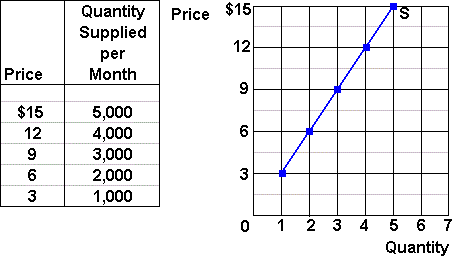
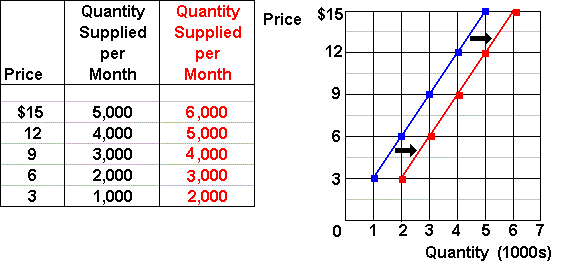
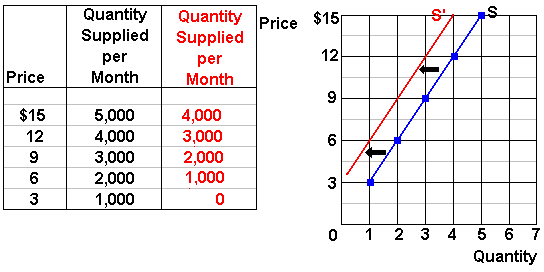
3b Review Videos
[4:54 YouTube ACDC
Leadership]
We are going to learn two
very important things in this lesson. First, we will put demand and
supply together and learn how to use the model to
to see why products have the prices that they do.
Then, and more importantly, we will see what causes
prices to change. If you hear on the news or
read in your news app, that the price of gasoline
is going down, we will be able to explain WHY. The
causes of changes in prices of products are the
five non-price determinants of demand (Pe, Pog, I,
Npot, T) and/or the six non-price determinants of
supply (Pe, Pog, Pres, Tech, Tax, Nprod.). Whenever
you hear that the price of something is changing
think of which of these 11 possible causes have
changed, draw the graph and shift the appropriate
demand and/or supply graph, and the graph will show
the price changing. Second, after we learn that
in a competitive market economy the interaction of
demand and supply will determine what the prices of
products will be and how much people will buy at
that price, we will ask: Is this the allocatively
efficient quantity and price? Our goal is to show
that in a competitive market the price will change
until allocative efficiency is achieved. In chapter
2 we learned that markets are allocatively
efficient. This means they will produce the
quantity of goods that maximizes the society's
satisfaction. After studying chapter 3 we will bew
able to show the allocatively efficient price and
quantity on a graph. Competitive markets are
efficient. Read the first few paragraphs
of Hybrid
Car Prices Increasing Due To High Gas
Prices. In lesson 3a you learned how
the non-price determinants of demand (Pe, Pog, I,
N, T) affect the demand curve. In lesson 3b you
learned how the non-price determinants of supply
(Pe, Pog, Pres, Tech, Tax, Nprod) affect the supply
curve. After studying this lesson
you will be able to use these determinants and
graphs to explain why prices change. For example
you will understand why: "It's becoming almost an
annual tradition: As fuel prices rise in the
spring, so do the prices of hybrid cars.
" Ch. 3 pp. 56-64,
69-74 Ch. 5: pp. 93-99, Efficiently
Functioning Markets PUTTING
SUPPLY AND DEMAND TOGETHER 2.3.2
Defining
Comparative Statics
7:02 [MyNotes] 2.3.3
Classifying
Comparative Statics
11:54 [MyNotes] AC
Micro
2.4 Double Shifts in Supply and Demand: Econ
Concepts in 60 Seconds
(2:34) MARKETS
AND EFFICIENCY TOPICS OUTCOMES Market
Equilibrium Markets and
Efficiency Non-Price Determinants of
Demand (PPINT) I -- income N -- number of POTENTIAL
consumers Non-Price Determinants of
Supply (PPPTTN) NON-PRICE DETERMINANTS OF
DEMAND Pe -- expected
price Pog -- price of other
goods 2) complementary goods I -- income 2) inferior goods Npot -- number of
POTENTIAL consumers T -- tastes and
preferences NON-PRICE DETERMINANTS OF
SUPPLY Pe -- expected
price Pog -- price of other
goods also produced by the same firm Pres -- price of
resources Tech
--technology Tax --taxes and
subsidies N -- number of
producers/sellers Key
Terms Flash Cards - Click Here Key Terms: Market Equilibrium Changes in Demand And
Supply Price Ceiling Price Floor - Shifting
Demand and Supply- Econ 2.3 - Double
Shifts- Econ 2.5 (Technical
Tuesday) - Price
Ceilings and Floors- Economics
2.6 NOTE: These are REVIEW videos
only. In order to learn the material you must read
the assigned textbook readings, watch the assigned
lecture videos, and do problems. See the LESSONS
link on Blackboard for these
assignments.
![]()
3c Introduction
3c Something Interesting -
Why are we studying this?
3c Assignments:
Readings
3c Assignments: Video
Lectures
2.3.1
Determining
a Competitive Equilibrium
11:04 [MyNotes]
EconMovies: Episode
4: Indiana Jones (Demand, Supply, Equilibrium,
Shifts) (7:02)
Efficiency
and Equilibrium in Competitive
Markets
(econclassroom.com 11:48) [begin at 7:27 and
stop at 8:44, we will not cover consumer and
producer surplus] [MyNotes]
3c Outcomes - What you
should learn
3a Non-Price Determinants of
Demand and Supply
Pe -- expected
price
Pog -- price of other goods
1) substitute
goods
2) complementary goods
3) independent goods1) normal
goods
2) inferior goods
T -- tastes and preferences Pe -- expected
price
Pog -- price of other goods produced by same
firm
Pres -- price of resources
T --technology
T --taxes and subsidies
N -- number of producers/sellers![]() Pe
in the future
Pe
in the future ![]()
![]() D today
D today
![]() Pe in the future
Pe in the future ![]()
![]() D today
D today1) substitute
goods
![]() P Maxwell House coffee
P Maxwell House coffee ![]()
![]() D Folgers coffee
D Folgers coffee
![]() P of one product
P of one product ![]()
![]() D of its substitute
D of its substitute
![]() P of wieners
P of wieners ![]()
![]() D of buns
D of buns
![]() P of one product
P of one product ![]()
![]() D of its compliment
D of its compliment1) normal goods
![]() Income
Income ![]()
![]() D for normal goods
D for normal goods
![]() Income
Income ![]()
![]() D for normal goods
D for normal goods
![]() Income
Income ![]()
![]() D for inferior goods
D for inferior goods
![]() Income
Income ![]()
![]() D for inferior goods
D for inferior goods![]() Npot
Npot ![]()
![]() D
D
![]() Npot
Npot ![]()
![]() D
D![]() Tastes for a product
Tastes for a product ![]()
![]() D for that product
D for that product
![]() Tastes for a product
Tastes for a product ![]()
![]() D for that product
D for that product ![]() Pe in the future
Pe in the future ![]()
![]() S today
S today
![]() Pe in the future
Pe in the future ![]()
![]() S today
S today![]() P soybeans
P soybeans ![]()
![]() S corn
S corn
![]() P soybeans
P soybeans ![]()
![]() S corn
S corn![]() worker's wages
worker's wages ![]()
![]() cost of making cars
cost of making cars ![]()
![]() S cars
S cars
![]() Pres
Pres ![]()
![]() costs
costs ![]()
![]() S
S
![]() Pres
Pres ![]()
![]() costs
costs ![]()
![]() S
SImproved technology
![]()
![]() costs
costs ![]()
![]() S
S![]() Taxes
Taxes ![]()
![]() costs
costs ![]()
![]() S
S
![]() Taxes
Taxes ![]()
![]() costs
costs ![]()
![]() S
S
![]() Subsidies
Subsidies ![]()
![]() costs
costs ![]()
![]() S
S
![]() Subsidies
Subsidies ![]()
![]() costs
costs ![]()
![]() S
S![]() Nproducers
Nproducers ![]()
![]() S
S
![]() Nproducers
Nproducers ![]()
![]() S
S
3c Key Terms
equilibrium, market
equilibrium, bidding mechanism, surplus,
shortage, scalping, productive efficiency,
allocative efficiency, marginal social benefits,
marginal social costs, "what we get", "what we
want", profit maximizing quantity,
underallocation of resources, overallocation of
resources, price ceiling, price floor
3c Practice Quiz (under
construction)
3c Key Graphs
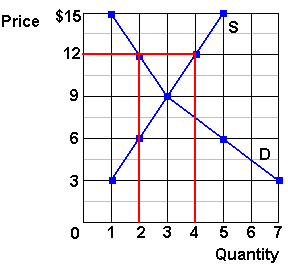
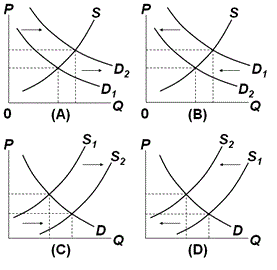
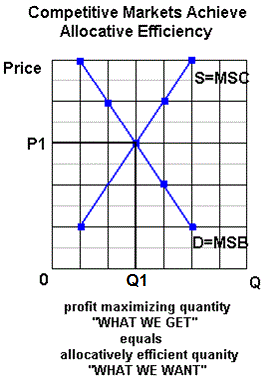
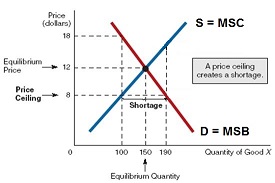
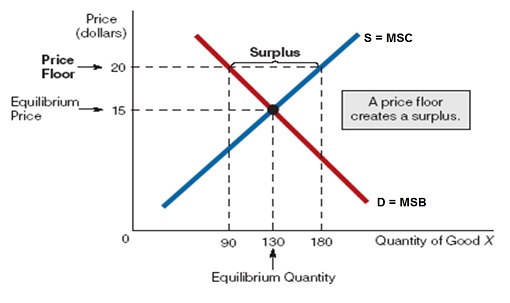
3c Review Videos
[4:49 YouTube ACDC Leadership]
[3:26 YouTube ACDC Leadership]
[4:34 YouTube ACDC Leadership]
In Lesson 2a we learned about
the following Structural Adjustment Policies and
the following characteristics of capitalist
economies: Structural Adjustment
Policies: Characteristics of
Capitalist Economies: In this lesson we will study
trade.Trade increases competition and helps the
world's economies achieve productive efficiency
(producing at a minimum cost by using resources
where they are best suited). Therefore it is an
important concept to study in any introductory
economics course. We will learn that trade
based on COMPARATIVE ADVANTAGE can help the world
PRODUCE MORE from the same amount of resources.
Trade allows all countries to consume beyond
their production possibilities (point E on the
graph below). How is that
possible? We will also learn that even
if a country is better at producing all products,
it is still possible for it to come out ahead if it
specializes and trades with other (less productive)
countries. How is that
possible? That is why more and more
countries are moving toward freer trade like the
proposed Trans-Pacific Partnership trade agreement
currently being discussed (see Lesson
20b). Read the first four
paragraphs of The
Mystical Power of Free Trade. After studying this lesson
you should understand: - and why "people resist this
conclusion, sometimes violently" Chapter 20: pp
398-407 "The Mystical
Power of Free Trade" VERY USEFUL: Lecture
Outline 1.5.1 Defining
Comparative Advantage with the Production
Possibilities Frontier
22:10 1.5.2 Understanding
Why Specialization Increases Total
Output 6:46
[MyNotes] 1.5.3 Analyzing
International Trade Using Comparative
Advantage 25:35
[MyNotes] 1.5.4 Outsourcing
8:54 [MyNotes] 17.4.3 Hot
Topic: Winners and Losers in
NAFTA 4:20
[MyNotes] OPTIONAL EC Determining
Comparative Advantage using PPCs – Worked
solutions to AP Free Response
Questions
(8:27) TOPICS OUTCOMES Key
Terms Flash Cards - Click Here Key Terms: Comparative Advantage and the
Gains from Trade - Comparative
advantage specialization and gains from trade |
Microeconomics | Khan
Academy NOTE: These are REVIEW videos
only. In order to learn the material you must read
the assigned textbook readings, watch the assigned
lecture videos, and do problems. See the LESSONS
link on Blackboard for these assignments.
![]()
20a Introduction
- Privatization
- Promotion of Competition
- Reduced Role of Government
- Removing Price Controls
- Freer Trade and Convertible Currency
- Foreign Investment
- private property
- freedom of enterprise and choice
- role of self interest
- competition -
- markets and prices
- limited role for government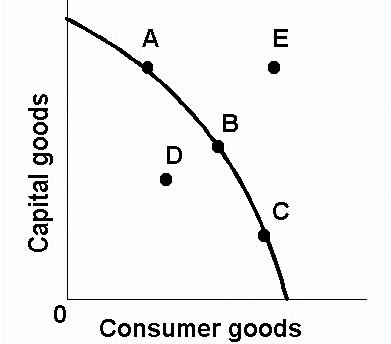
20a Something Interesting -
Why are we studying this?
- why "society
benefits from allowing its citizens to buy what
they wish--even from foreigners." (i.e. the
gains from trade),
20a Assignments:
Readings
http://www.cnn.com/ALLPOLITICS/time/1999/12/06/free.trade.html
20a Assignments: Video
Lectures
[MyNotes]KA Comparative
advantage specialization and gains from
trade
(8:55)
20a Outcomes - What you
should learn
20a Key Terms
opportunity cost,
constant costs, increasing costs, absolute
advantage, comparative advantage, gains from
trade, free trade, terms of trade, minimum and
maximum terms of trade
20a Practice Quiz (under
construction)
20a Key Graphs
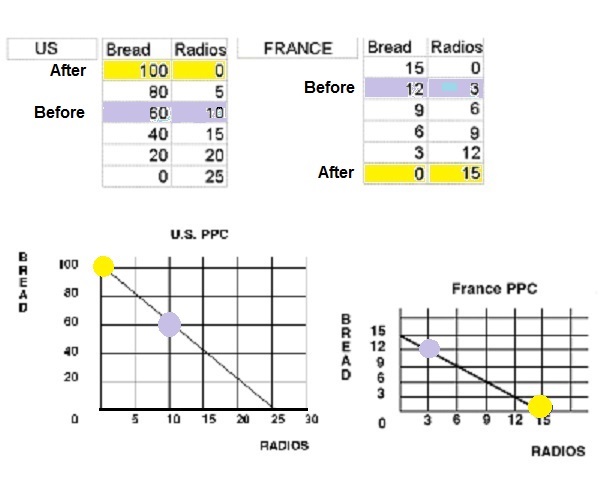
20a Review
Videos
[8:55 YouTube Khan Academy]
Everything discussed in
Lesson 20a about trade (specialization and
exchange) can be applied to trade between
individuals, cities, counties, states, and
countries. In this lesson we will focus
specifically on INTERNATIONAL trade (trade between
countries). Comparative advantage still
applies, but there are some differences between
INTERnational trade (trade between countries) and
INTRAnational trade (trade within a country). These
differences include greater distances, politics,
and the use of different currencies. Lesson 20b begins with a
review of the FACTS of international trade (see:
Lecture
Outline). Then we
will look at what happens when politicians restrict
trade (and therefore cause inefficiency). And we
will finish up with learning how to use a supply
and demand graph to understand why exchange rates
change. Concerning exchange rates:
students often believe that a strong dollar is good
and a weak dollar is bad. This is not always true.
If the U.S. dollar appreciates (increases in value)
it is often called a "strong dollar". What a strong
dollar does is make it cheaper for Americans to buy
foreign imports (or make it cheaper to take a ski
trip in Canada). A strong dollar also makes it more
expensive for foreigners to purchase U.S. exports.
Therefore, a strong dollar may be good for
consumers because of cheap imports, but bad for
workers because of less exports, fewer jobs, and
more unemployment). The link below goes to a
LIST of articles on the Trans Pacific
Partnership (TPP) trade agreement found on the
Huffington Post news site. The Huffington Post
tends to be a more liberal, and less free trade,
news site. Scroll down just looking at the
titiles of the news articles over the last few
months. You will see that many of them appear to
oppose the TPP trade agreement. Trans
Pacific Partnership After studying this lesson
you will have a better understanding of why many
people oppose such trade agreements BUT most
economists say that such agreements benefit the US
economy and the world economy. Textbook - Trade
Barriers and Export Subsidies, pp.
411-414 - The Case for
Protection, pp. 414-416 - Multilateral
Trade Agreements and Free-Trade Zones, pp.
416-418 - The Last
Word - "Petition of the Candlemakers, 1845": p.
419 - Flexible
Exchange Rates pp. 429-432; - Recent U.S.
Trade Deficits pp.438-439 Trans-Pacific
Partnership VERY USEFUL: Lecture
Outline 17.4.2 Trade
Policy 7:17
[MyNotes] 17.1.1 Determining
the Difference between a Closed Economy and an Open
Economy 8:55
[MyNotes] Why
do Countries Restrict Trade?
(8:34) [MyNotes] Types
of Trade Restrictions
(9:43) [MyNotes] 17.1.2 Understanding
Exports in an Open Economy
5:22 [MyNotes] 17.3.1 Nominal
Exchange Rates 11:32
[MyNotes] 17.3.4 Determination
of Exchange Rates
12:31 [MyNotes] 17.3.5 Floating
and Fixed Systems
13:18 [MyNotes] TOPICS OUTCOMES Key
Terms Flash Cards - Click Here Key Terms: Graph used to show the
effects of a tariff (trade restriction): Exchange Rates: - Episode
35: Why do countries restrict trade? - Foreign
Exchange (FOREX)- Macro 5.2 NOTE: These are REVIEW videos
only. In order to learn the material you must read
the assigned textbook readings, watch the assigned
lecture videos, and do problems. See the LESSONS
link on Blackboard for these assignments.
In chapter 12 we develop a
model of the macroeconomy, the Aggregate Demand /
Aggregate Supply model (AS/AD), that we will use
throughout the remainder of the course. Remember
from chapter 1 that the three macroeconomics issues
are unemployment (UE), inflation (IN), and economic
growth (EG). The AD/AS model will help us
understand changes in UE, IN, and EG. In lesson 12a we briefly
introduce UE, IN, and EG and then develop the
aggregate demand curve (AD). In lesson 12b we will
develop the aggregate supply (AS) curve and then
put them together to find a macroeconomic
equilibrium. Then, similar to what we did in
chapter 3, we will see that changes in the
determinants of AD or AS cause the curves to shift
resulting in changes in UE, IN, and EG. LEARN THE
DETERMINANTS! See the Yellow Pages for lists of the
determinants and many practice exercises.
One last thing, even though
the AS/AD graph looks very similar to the supply
and demand graph from chapter 3, THEY ARE VERY
DIFFERENT. Whereas in chapter 3 we looked at the
price and quantity of a SINGLE PRODUCT, in
macroeconomics we look at the price level
and the aggregate output in the WHOLE
ECONOMY. We are not just looking at one product, we
are looking at the average prices of ALL products
and the quantities of ALL products produced in an
economy. Read the first 5 paragraphs
and and paragraph 10 in the link below where Joseph
Stiglitz explains how the lack of Aggregate Demand
(AD) is currently causing slow or no economic
growth around the world. Why
the Great Malaise of the World Economy Continues in
2016, From Wikipedia: "Joseph
Eugene Stiglitz . . . is an American economist and
a professor at Columbia University. He is a
recipient of the Nobel Memorial Prize in Economic
Sciences . . . . He is a former senior vice
president and chief economist of the World Bank and
is a former member and chairman of the Council of
Economic Advisers, [under president
Clinton]. . . . Based on academic citations,
Stiglitz is the 4th most influential economist in
the world today, and in 2011 he was named by Time
magazine as one of the 100 most influential people
in the world." Ch. 6: pp. 116-120 Ch. 9: The Business Cycle:
pp. 171-173 Chapter 12 - Aggregate Supply
and Aggregate Demand pp. 233-238 BUSINESS CYCLES 11.1.2 Theoretical
Explanations for Cycles
10:09 [MyNotes] AGGREGATE DEMAND 14.1.2 Movement
along the Aggregate Demand
Curve 9:15
[MyNotes] 14.1.3 Shifts
in Aggregate Demand
6:03 [MyNotes] TOPICS OUTCOMES DETERMNANTS of
AD DETERMNANTS of
AD Consumption (C) Investment (I) Government Purchases
(G) Net Exports (Xn) Money Supply (MS) Taxes (T) Saving (S) DETERMINANTS of
AD C = consumer spending (and
saving) 2. consumer
expectations 3. consumer
indebtedness 4. taxes I = investment
spending 2. profit expectations on
investment projects 3. business
taxes 4. technology 5. degree of excess
capacity G = government purchases (no
determinants) Xn = net export
spending 2. exchange
rates Determinants of AS
DETERMINANTS OF
AS Productivity of
Resources Business Taxes and Gov't
Regulations Key
Terms Flash Cards - Click Here Key Terms: The 5Es and Macroeconomic
Issues The Business Cycle Aggregate Demand
(AD) Increase in AD / Decrease in
AD - Macro
2.7- Business Cycle Unit Summary - Macro
3.1- Aggregate Demand
Practice NOTE: These are REVIEW videos
only. In order to learn the material you must read
the assigned textbook readings, watch the assigned
lecture videos, and do problems. See the LESSONS
link on Blackboard for these assignments.
![]()
20b Introduction
20b Something Interesting -
Why are we studying this?
http://www.huffingtonpost.com/news/trans-pacific-partnership/
20b Assignments:
Readings
- Some Key Trade
Facts pp. 398-400
- http://www.nytimes.com/2015/05/12/business/unpacking-the-trans-pacific-partnership-trade-deal.html
20b Assignments: Video
Lectures
20b Outcomes - What you
should learn
20b Key Terms
imports, exports,
trade barriers, tariff, revenue tariff,
protective tariff, import quota, nontariff
barrier, export subsidies, special interest
effect, infant industry, dumping, WTO, NAFTA,
TPP, offshoring, exchange rate, strong dollar,
weak dollar, appreciation, depreciation, trade
deficit, trade surplus
20b Practice Quiz (under
construction)
20b Key Graphs


20b Review
Videos
[8:34 YouTube
mjmfoodie]
[8:34 YouTube ACDC Leadership ]
![]()
12a Introduction
12a Something Interesting -
Why are we studying this?
Joseph E. Stiglitz
http://www.huffingtonpost.com/joseph-e-stiglitz/world-economy-2016_b_8908560.html
12a Assignments:
Readings
12a Assignments: Video
Lectures
11.1.1
The
Business Cycle Recessions, Depressions, and
Booms 2:59
[MyNotes]
14.1.1
Deriving
the Aggregate Demand
Curve 7:26
[MyNotes]
12a Outcomes - What you
should learn
[Define, Draw, Describe,
Determinants]
12a Determinants of AD and
AS
![]() AD__________
AD__________
![]() AD___________
AD___________
![]() C
C ![]()
![]() AD
AD
![]() C
C ![]()
![]() AD
AD
![]() I
I ![]()
![]() AD
AD
![]() I
I ![]()
![]() AD
AD
![]() G
G ![]()
![]() AD
AD
![]() G
G ![]()
![]() AD
AD
![]() Xn
Xn ![]()
![]() AD
AD
![]() Xn
Xn ![]()
![]() AD
AD
![]() MS
MS ![]()
![]() Int. Rt.
Int. Rt. ![]()
![]() I
I ![]()
![]() AD
AD
![]() MS
MS ![]()
![]() Int. Rt.
Int. Rt. ![]()
![]() I
I ![]()
![]() AD
AD
![]() T
T ![]()
![]() C
C ![]()
![]() AD
AD
![]() T
T ![]()
![]() C
C ![]()
![]() AD
AD
![]() S
S ![]()
![]() C
C ![]()
![]() AD
AD
![]() S
S ![]()
![]() C
C ![]()
![]() AD
AD![]() C
C
![]()
![]() AD
AD
![]() C
C ![]()
![]() AD
AD![]() I
I ![]()
![]() AD
AD
![]() I
I ![]()
![]() AD
AD![]() G
G ![]()
![]() AD
AD
![]() G
G ![]()
![]() AD
AD![]() Xn
Xn ![]()
![]() AD
AD
![]() Xn
Xn ![]()
![]() AD
AD![]() MS
MS ![]()
![]() Interest Rates
Interest Rates ![]()
![]() I
I ![]()
![]() AD
AD
![]() MS
MS ![]()
![]() Interest Rates
Interest Rates ![]()
![]() I
I ![]()
![]() AD
AD![]() T
T ![]()
![]() C
C ![]()
![]() AD
AD
![]() T
T ![]()
![]() C
C ![]()
![]() AD
AD![]() S
S ![]()
![]() C
C ![]()
![]() AD
AD
![]() S
S ![]()
![]() C
C ![]()
![]() AD
AD1. consumer
wealth
![]() Wealth
Wealth ![]()
![]() C
C ![]()
![]() AD
AD
![]() Wealth
Wealth ![]()
![]() C
C ![]()
![]() AD
AD![]() Expected future Income
Expected future Income ![]()
![]() C today
C today ![]()
![]() AD today
AD today
![]() Expected future Income
Expected future Income ![]()
![]() C today
C today ![]()
![]() AD today
AD today![]() Consumer Debt
Consumer Debt ![]()
![]() C
C ![]()
![]() AD
AD
![]() Consumer Debt
Consumer Debt ![]()
![]() C
C ![]()
![]() AD
AD![]() T
T ![]()
![]() C
C ![]()
![]() AD
AD
![]() T
T ![]()
![]() C
C ![]()
![]() AD
AD1. interest rates
(money supply)
![]() MS
MS ![]()
![]() Interest Rates
Interest Rates ![]()
![]() I
I ![]()
![]() AD (memorize this)
AD (memorize this)
![]() MS
MS ![]()
![]() Interest Rates
Interest Rates ![]()
![]() I
I ![]()
![]() AD
AD![]() profit expectations
profit expectations ![]()
![]() I
I ![]()
![]() AD
AD
![]() profit expectations
profit expectations ![]()
![]() I
I ![]()
![]() AD
AD![]() Business Taxes
Business Taxes ![]()
![]() I
I ![]()
![]() AD
AD
![]() Business Taxes
Business Taxes ![]()
![]() I
I ![]()
![]() AD
ADtechnology
improves
![]()
![]() I
I ![]()
![]() AD
AD![]() excess (unused) plant capacity
excess (unused) plant capacity ![]()
![]() I
I ![]()
![]() AD
AD
![]() excess
(unused) plant capacity
excess
(unused) plant capacity ![]()
![]() I
I ![]()
![]() AD
AD1. net income
abroad
![]() Income in Foreign Countries
Income in Foreign Countries ![]()
![]() Xn
Xn ![]()
![]() AD
AD
![]() Income in Foreign Countries
Income in Foreign Countries ![]()
![]() Xn
Xn ![]()
![]() AD
AD![]() value of the US dollar
value of the US dollar ![]()
![]() Xn
Xn ![]()
![]() AD
AD
![]() value of the US dollar
value of the US dollar ![]()
![]() Xn
Xn ![]()
![]() AD
AD
![]() AS__________
AS__________
![]() AS__________
AS__________
![]() price of resources
price of resources ![]()
![]() AS
AS
![]() price of resources
price of resources ![]()
![]() AS
AS
![]() productivity
productivity ![]()
![]() AS
AS
![]() productivity
productivity ![]()
![]() AS
AS
![]() business taxes and gov't red tape
business taxes and gov't red tape
![]()
![]() AS
AS
![]() business taxes and gov't red tape
business taxes and gov't red tape
![]()
![]() AS
ASPrice of
Resources
![]() price of resources
price of resources ![]()
![]() AS
AS
![]() price of resources
price of resources ![]()
![]() AS
AS![]() productivity
productivity ![]()
![]() AS
AS
![]() productivity
productivity ![]()
![]() AS
AS![]() business taxes and gov't red tape
business taxes and gov't red tape ![]()
![]() A S
A S
![]() business taxes and gov't red tape
business taxes and gov't red tape ![]()
![]() AS
AS
12a Key Terms
real GDP,
unemployment, inflation, modern economic growth,
saving, economic investment, financial
investment, business cycle, peak, recession,
trough, expansion (recovery), growth trend
(secular trend), aggregate demand (AD),
real-balances effect, interest-rate effect,
foreign-purchases effect, determinants of
aggregate demand, wealth vs. income, investment
(investment spending)
12a Practice Quiz (under
construction)
12a Formulas
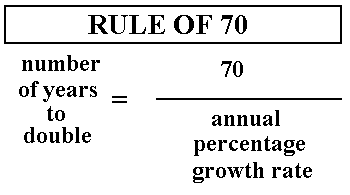
GDP = C + Ig + G +
Xn
12a Key Graphs
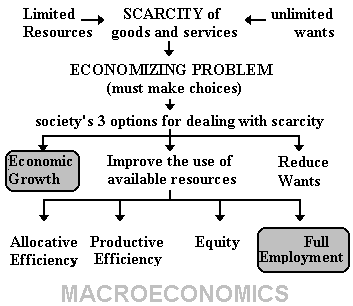
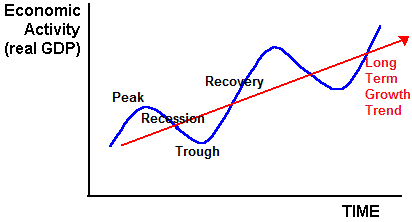

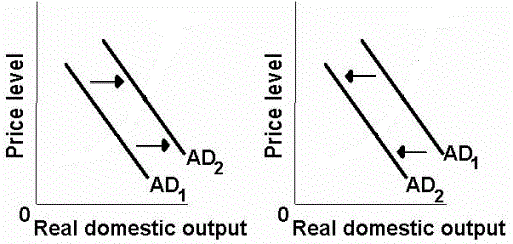
12a Review
Videos
[1:32 YouTube ACDC
Leadership]
[3:21 YouTube ACDC Leadership]
Almost everyday we can find
news about unemployment (UE), inflation (IN), and
economic growth (EG). People discuss these issues
over coffee and presidential candidates discuss
them during debates. Our elected leaders consider
them in pieces of legislation. How can we gain a
better understanding of the causes of unemployment,
inflation, and economic growth so that we can
better understand these discussions? To economists
the answer is the Aggregate Demand / Aggregate
Supply model of the macroeconomy. In this lesson we will add
aggregate supply to our aggregate demand graph
(lesson 12a) and use the combined graphs to find
the equilibrium level of real GDP (output) and
price level. We will see what causes the
equilibrium level of real GDP (output) and price
level of an economy to change (the determinants of
AD and AS), and we will use such changes to gain a
better understanding of the causes of UE, IN, and
EG. So the next time you hear a
politician discuss what they plan to do about UE,
IN, and EG, you will have a much better
understanding of what the are saying. Low oil prices boost economic
growth: From: Dallas Fed Vol. 10
No. 3, April 2015, "Economic Letter - Plunging
Oil Prices: A Boost for the U.S. Economy, a Jolt
for Texas" by Anthony Murphy, Michael Plante and
Mine Yücel https://www.dallasfed.org/assets/documents/research/eclett/2015/el1503.pdf After this lesson you should
be able to use an AS/AD graph to illustrate the
effects of low oil prices on the US economy and use
the graph to explan what should happen to UE, IN,
and EG. Chapter 12 - Aggregate Supply
and Aggregate Demand 238-250 Ch. 9: Types of Inflation:
pp. 179-180 Review Ch. 1: "Present
Choices, Future Possibilities": pp.
16-18 AGGREGATE SUPPLY 14.2.2 The
Labor Market 7:20
[MyNotes] EQUILIBRIUM 14.3.7 Hot
Topic: Oil Shocks
4:52 [MyNotes] TOPICS OUTCOMES DETERMNANTS of
AD DETERMNANTS of
AD Consumption (C) Investment (I) Government Purchases
(G) Net Exports (Xn) Money Supply (MS) Taxes (T) Saving (S) DETERMINANTS of
AD C = consumer spending (and
saving) 2. consumer
expectations 3. consumer
indebtedness 4. taxes I = investment
spending 2. profit expectations on
investment projects 3. business
taxes 4. technology 5. degree of excess
capacity G = government purchases (no
determinants) Xn = net export
spending 2. exchange
rates Determinants of AS
DETERMINANTS OF
AS Productivity of
Resources Business Taxes and Gov't
Regulations Key
Terms Flash Cards - Click Here Key Terms: GDP = C + I + G +
Xn Aggregate (AS)
Supply Increase in AS / Decrease in
AS Macroeconomic
Equilibrium Change (Increase) in
AD Change (Increase) in
AS - Macro
3.2- Aggregate Supply Practice - Macro
3.3- Long Run Aggregate Supply, Recession, and
Inflation (LRAS) NOTE: These are REVIEW videos
only. In order to learn the material you must read
the assigned textbook readings, watch the assigned
lecture videos, and do problems. See the LESSONS
link on Blackboard for these assignments.
Now that we have a tool to
use to better understand what causes changes in UE,
IN, and EG, let's look at what the government can
do to reduce high UE and high IN. What are the
government POLICIES that can reduce UE and reduce
IN? Luckily, this is one concept
where the terminology used by economists is also
used by everybody else. So when you read about
"fiscal policy" and "monetary policy" in your
textbook and in the newspaper, they mean the same
thing! We will finish this lesson
with a review of the economic history of United
States. You have all heard about the "Great
Depression" (1929-1939). Let's see if we can use
what we have learned (the AD/AS model) to better
understand its causes and why it ended. Recessions
and Fiscal Policy- EconMovies #5:
Cars Expansionary
fiscal policy YouTube
Edward Bahaw 1:53 Ch. 13: Fiscal Policy and the
AD-AS Model: pp. 258-261 Ch. 18: Taxation and AS
(Supply-Side Economics): pp. 374-378 Ch. 18: From Short Run to
Long Run / Applying the Extended AS-AS Model - pp.
362-368 Ch. 18: The IN-UE
Relationship 368-374 (The Phillips
Curve) Fiscal Policy and Economic
History of the U.S. Historical
circumstances explained by AD/AS: Real GDP
driving price
(Khan Academy 6:15) Historical
circumstances explained by AD/AS : Cost-push
inflation (Khan
Academy 5:45) Long-Run AS 14.3.3 Equilibrium
in the Long Run
7:32 14.3.4 Expectations
in the Long Run and the Short
Run 14:36
[MyNotes] 14.3.5 Long-Run
Macroeconomic Equilibrium
16:55 [MyNotes] Phillips
Curve 14.4.2 Expectations
and the Phillips Curve
9:15 [MyNotes] TOPICS OUTCOMES Using the AS/AD model
explain and show how an econmy will "correct
itself" if it has high unemployment. DETERMNANTS of
AD DETERMNANTS of
AD Consumption (C) Investment (I) Government Purchases
(G) Net Exports (Xn) Money Supply (MS) Taxes (T) Saving (S) DETERMINANTS of
AD C = consumer spending (and
saving) 2. consumer
expectations 3. consumer
indebtedness 4. taxes I = investment
spending 2. profit expectations on
investment projects 3. business
taxes 4. technology 5. degree of excess
capacity G = government purchases (no
determinants) Xn = net export
spending 2. exchange
rates Determinants of AS
DETERMINANTS OF
AS Productivity of
Resources Business Taxes and Gov't
Regulations Key
Terms Flash Cards - Click Here Key Terms: Laffer Curve Long Run AS Long Run AS - Adjusting to an
increase in AD Long Run AS - Adjusting to a
decrease in AD Philips Curve - Fiscal
& Monetary Policy Review- AP
Macroeconomics
3:58 - Macro
3.3- Long Run Aggregate Supply, Recession, and
Inflation (LRAS) - The
Phillips Curve (Macro Review) Macro 3.4
NOTE: These are REVIEW videos
only. In order to learn the material you must read
the assigned textbook readings, watch the assigned
lecture videos, and do problems. See the LESSONS
link on Blackboard for these assignments.
![]()
(UE, IN, EG)
12b Introduction
12b Something Interesting -
Why are we studying this?
"Sinking prices have
implications for economies across the globe.
Important oil exporters, such as the OPEC
countries, bear the brunt of negative impacts,
while oil importers benefit. Overall economic
activity in the U.S. will benefit, although
lower oil prices will depress activity in many
producing states, such as Texas and North
Dakota..... Depending on which economic model is
used, a 50 percent oil price decline yields a
0.3 to 1 percent increase in U.S. GDP. The
traditional rule of thumb has been that a
sustained 50 percent lower crude oil price
raises the growth rate by about 1 percentage
point. However, since the U.S. produces more oil
and uses it more efficiently nowadays, the
traditional rule of thumb should probably be
halved—the reduction should boost U.S.
growth 0.5 percentage point for a year or
so."
12b Assignments:
Readings
12b Assignments: Video
Lectures
14.2.1
The
Short-Run Aggregate Supply
Curve 9:03
[MyNotes]
14.3.2
Equilibrium
in the Short Run
12:10 [MyNotes]
12b Outcomes - What you
should learn
[Define, Draw, Describe,
Determinants]
12a Determinants of AD and
AS
![]() AD__________
AD__________
![]() AD___________
AD___________
![]() C
C ![]()
![]() AD
AD
![]() C
C ![]()
![]() AD
AD
![]() I
I ![]()
![]() AD
AD
![]() I
I ![]()
![]() AD
AD
![]() G
G ![]()
![]() AD
AD
![]() G
G ![]()
![]() AD
AD
![]() Xn
Xn ![]()
![]() AD
AD
![]() Xn
Xn ![]()
![]() AD
AD
![]() MS
MS ![]()
![]() Int. Rt.
Int. Rt. ![]()
![]() I
I ![]()
![]() AD
AD
![]() MS
MS ![]()
![]() Int. Rt.
Int. Rt. ![]()
![]() I
I ![]()
![]() AD
AD
![]() T
T ![]()
![]() C
C ![]()
![]() AD
AD
![]() T
T ![]()
![]() C
C ![]()
![]() AD
AD
![]() S
S ![]()
![]() C
C ![]()
![]() AD
AD
![]() S
S ![]()
![]() C
C ![]()
![]() AD
AD![]() C
C
![]()
![]() AD
AD
![]() C
C ![]()
![]() AD
AD![]() I
I ![]()
![]() AD
AD
![]() I
I ![]()
![]() AD
AD![]() G
G ![]()
![]() AD
AD
![]() G
G ![]()
![]() AD
AD![]() Xn
Xn ![]()
![]() AD
AD
![]() Xn
Xn ![]()
![]() AD
AD![]() MS
MS ![]()
![]() Interest Rates
Interest Rates ![]()
![]() I
I ![]()
![]() AD
AD
![]() MS
MS ![]()
![]() Interest Rates
Interest Rates ![]()
![]() I
I ![]()
![]() AD
AD![]() T
T ![]()
![]() C
C ![]()
![]() AD
AD
![]() T
T ![]()
![]() C
C ![]()
![]() AD
AD![]() S
S ![]()
![]() C
C ![]()
![]() AD
AD
![]() S
S ![]()
![]() C
C ![]()
![]() AD
AD1. consumer
wealth
![]() Wealth
Wealth ![]()
![]() C
C ![]()
![]() AD
AD
![]() Wealth
Wealth ![]()
![]() C
C ![]()
![]() AD
AD![]() Expected future Income
Expected future Income ![]()
![]() C today
C today ![]()
![]() AD today
AD today
![]() Expected future Income
Expected future Income ![]()
![]() C today
C today ![]()
![]() AD today
AD today![]() Consumer Debt
Consumer Debt ![]()
![]() C
C ![]()
![]() AD
AD
![]() Consumer Debt
Consumer Debt ![]()
![]() C
C ![]()
![]() AD
AD![]() T
T ![]()
![]() C
C ![]()
![]() AD
AD
![]() T
T ![]()
![]() C
C ![]()
![]() AD
AD1. interest rates
(money supply)
![]() MS
MS ![]()
![]() Interest Rates
Interest Rates ![]()
![]() I
I ![]()
![]() AD (memorize this)
AD (memorize this)
![]() MS
MS ![]()
![]() Interest Rates
Interest Rates ![]()
![]() I
I ![]()
![]() AD
AD![]() profit expectations
profit expectations ![]()
![]() I
I ![]()
![]() AD
AD
![]() profit expectations
profit expectations ![]()
![]() I
I ![]()
![]() AD
AD![]() Business Taxes
Business Taxes ![]()
![]() I
I ![]()
![]() AD
AD
![]() Business Taxes
Business Taxes ![]()
![]() I
I ![]()
![]() AD
ADtechnology
improves
![]()
![]() I
I ![]()
![]() AD
AD![]() excess (unused) plant capacity
excess (unused) plant capacity ![]()
![]() I
I ![]()
![]() AD
AD
![]() excess
(unused) plant capacity
excess
(unused) plant capacity ![]()
![]() I
I ![]()
![]() AD
AD1. net income
abroad
![]() Income in Foreign Countries
Income in Foreign Countries ![]()
![]() Xn
Xn ![]()
![]() AD
AD
![]() Income in Foreign Countries
Income in Foreign Countries ![]()
![]() Xn
Xn ![]()
![]() AD
AD![]() value of the US dollar
value of the US dollar ![]()
![]() Xn
Xn ![]()
![]() AD
AD
![]() value of the US dollar
value of the US dollar ![]()
![]() Xn
Xn ![]()
![]() AD
AD
![]() AS__________
AS__________
![]() AS__________
AS__________
![]() price of resources
price of resources ![]()
![]() AS
AS
![]() price of resources
price of resources ![]()
![]() AS
AS
![]() productivity
productivity ![]()
![]() AS
AS
![]() productivity
productivity ![]()
![]() AS
AS
![]() business taxes and gov't red tape
business taxes and gov't red tape
![]()
![]() AS
AS
![]() business taxes and gov't red tape
business taxes and gov't red tape
![]()
![]() AS
ASPrice of
Resources
![]() price of resources
price of resources ![]()
![]() AS
AS
![]() price of resources
price of resources ![]()
![]() AS
AS![]() productivity
productivity ![]()
![]() AS
AS
![]() productivity
productivity ![]()
![]() AS
AS![]() business taxes and gov't red tape
business taxes and gov't red tape ![]()
![]() A S
A S
![]() business taxes and gov't red tape
business taxes and gov't red tape ![]()
![]() AS
AS
12b Key Terms
AS,
immediate-short-run AS, short-run AS, long-run
AS, Keynesian range, Intermediate range,
Classical range, equilibrium
price level, equilibrium real output (RDO),
demand-pull inflation, cost-push inflation,
efficiency wages, ratchet effect, stagflation,
OPEC
12b Practice Quiz (under
construction)
12b Formulas
12b Key Graphs
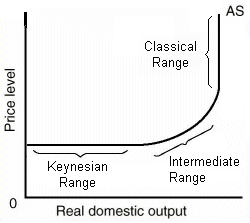
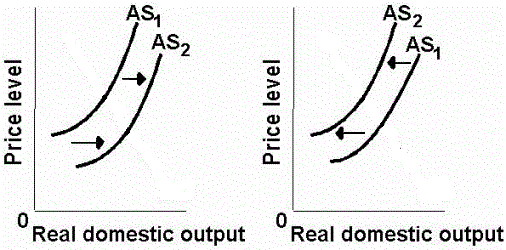
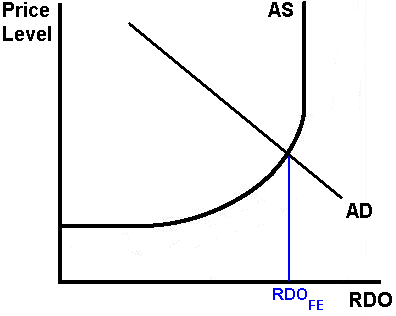
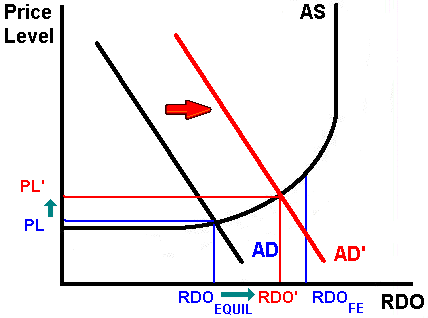
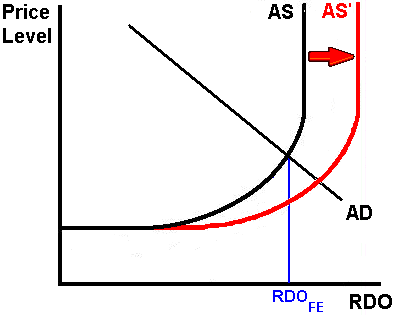
12b Review
Videos
[2:10 YouTube ACDC
Leadership]
[Beginning to 1:50 YouTube ACDC
Leadership]
![]()
12c Introduction
12c Something Interesting -
Why are we studying this?
YouTube ACDC Leadership 5:45
12c Assignments:
Readings
12c Assignments: Video
Lectures
Historical
circumstances explained by AD/AS: Demand-pull
inflation under Johnson
(Khan Academy 9:18)
14.2.3
The
Long-Run Aggregate Supply
Curve 11:17
[MyNotes]
14.4.1
The
Phillips Curve: Definitions and the Historical
Record 13:38
[MyNotes]
12c Outcomes - What you
should learn
[![]() MS
MS
![]()
![]() interest
rates
interest
rates ![]()
![]() I
I ![]()
![]() AD]
AD]
Using the AS/AD model explain and show how an
economy will "correct itself" if it has high
inflation.
12a Determinants of AD and
AS
![]() AD__________
AD__________
![]() AD___________
AD___________
![]() C
C ![]()
![]() AD
AD
![]() C
C ![]()
![]() AD
AD
![]() I
I ![]()
![]() AD
AD
![]() I
I ![]()
![]() AD
AD
![]() G
G ![]()
![]() AD
AD
![]() G
G ![]()
![]() AD
AD
![]() Xn
Xn ![]()
![]() AD
AD
![]() Xn
Xn ![]()
![]() AD
AD
![]() MS
MS ![]()
![]() Int. Rt.
Int. Rt. ![]()
![]() I
I ![]()
![]() AD
AD
![]() MS
MS ![]()
![]() Int. Rt.
Int. Rt. ![]()
![]() I
I ![]()
![]() AD
AD
![]() T
T ![]()
![]() C
C ![]()
![]() AD
AD
![]() T
T ![]()
![]() C
C ![]()
![]() AD
AD
![]() S
S ![]()
![]() C
C ![]()
![]() AD
AD
![]() S
S ![]()
![]() C
C ![]()
![]() AD
AD![]() C
C
![]()
![]() AD
AD
![]() C
C ![]()
![]() AD
AD![]() I
I ![]()
![]() AD
AD
![]() I
I ![]()
![]() AD
AD![]() G
G ![]()
![]() AD
AD
![]() G
G ![]()
![]() AD
AD![]() Xn
Xn ![]()
![]() AD
AD
![]() Xn
Xn ![]()
![]() AD
AD![]() MS
MS ![]()
![]() Interest Rates
Interest Rates ![]()
![]() I
I ![]()
![]() AD
AD
![]() MS
MS ![]()
![]() Interest Rates
Interest Rates ![]()
![]() I
I ![]()
![]() AD
AD![]() T
T ![]()
![]() C
C ![]()
![]() AD
AD
![]() T
T ![]()
![]() C
C ![]()
![]() AD
AD![]() S
S ![]()
![]() C
C ![]()
![]() AD
AD
![]() S
S ![]()
![]() C
C ![]()
![]() AD
AD1. consumer
wealth
![]() Wealth
Wealth ![]()
![]() C
C ![]()
![]() AD
AD
![]() Wealth
Wealth ![]()
![]() C
C ![]()
![]() AD
AD![]() Expected future Income
Expected future Income ![]()
![]() C today
C today ![]()
![]() AD today
AD today
![]() Expected future Income
Expected future Income ![]()
![]() C today
C today ![]()
![]() AD today
AD today![]() Consumer Debt
Consumer Debt ![]()
![]() C
C ![]()
![]() AD
AD
![]() Consumer Debt
Consumer Debt ![]()
![]() C
C ![]()
![]() AD
AD![]() T
T ![]()
![]() C
C ![]()
![]() AD
AD
![]() T
T ![]()
![]() C
C ![]()
![]() AD
AD1. interest rates
(money supply)
![]() MS
MS ![]()
![]() Interest Rates
Interest Rates ![]()
![]() I
I ![]()
![]() AD (memorize this)
AD (memorize this)
![]() MS
MS ![]()
![]() Interest Rates
Interest Rates ![]()
![]() I
I ![]()
![]() AD
AD![]() profit expectations
profit expectations ![]()
![]() I
I ![]()
![]() AD
AD
![]() profit expectations
profit expectations ![]()
![]() I
I ![]()
![]() AD
AD![]() Business Taxes
Business Taxes ![]()
![]() I
I ![]()
![]() AD
AD
![]() Business Taxes
Business Taxes ![]()
![]() I
I ![]()
![]() AD
ADtechnology
improves
![]()
![]() I
I ![]()
![]() AD
AD![]() excess (unused) plant capacity
excess (unused) plant capacity ![]()
![]() I
I ![]()
![]() AD
AD
![]() excess
(unused) plant capacity
excess
(unused) plant capacity ![]()
![]() I
I ![]()
![]() AD
AD1. net income
abroad
![]() Income in Foreign Countries
Income in Foreign Countries ![]()
![]() Xn
Xn ![]()
![]() AD
AD
![]() Income in Foreign Countries
Income in Foreign Countries ![]()
![]() Xn
Xn ![]()
![]() AD
AD![]() value of the US dollar
value of the US dollar ![]()
![]() Xn
Xn ![]()
![]() AD
AD
![]() value of the US dollar
value of the US dollar ![]()
![]() Xn
Xn ![]()
![]() AD
AD
![]() AS__________
AS__________
![]() AS__________
AS__________
![]() price of resources
price of resources ![]()
![]() AS
AS
![]() price of resources
price of resources ![]()
![]() AS
AS
![]() productivity
productivity ![]()
![]() AS
AS
![]() productivity
productivity ![]()
![]() AS
AS
![]() business taxes and gov't red tape
business taxes and gov't red tape
![]()
![]() AS
AS
![]() business taxes and gov't red tape
business taxes and gov't red tape
![]()
![]() AS
ASPrice of
Resources
![]() price of resources
price of resources ![]()
![]() AS
AS
![]() price of resources
price of resources ![]()
![]() AS
AS![]() productivity
productivity ![]()
![]() AS
AS
![]() productivity
productivity ![]()
![]() AS
AS![]() business taxes and gov't red tape
business taxes and gov't red tape ![]()
![]() A S
A S
![]() business taxes and gov't red tape
business taxes and gov't red tape ![]()
![]() AS
AS
12c Key Terms
stabilization
policies, demand management, fiscal policy (FP),
expansionary FP, contractionary FP, monetary
policy (MP), easy (expansionary) MP, tight
(contractionary) MP, supply-side policy, Laffer
curve, stagflation, aggregate supply shocks,
short run, long run, long-run AS, Phillips
curve, long-run Phillips Curve, the Great
Depression, disinflation
12c Practice Quiz (under
construction)
12c Key Graphs
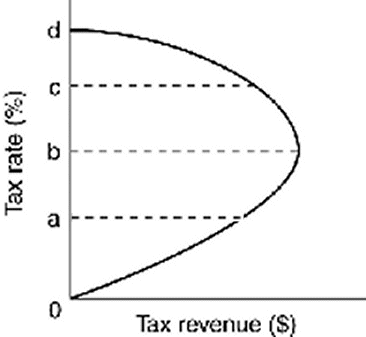
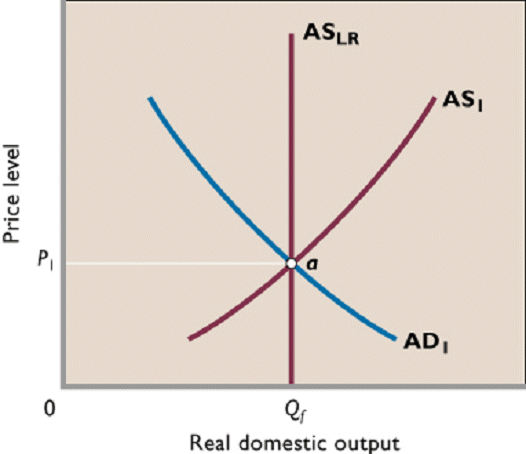
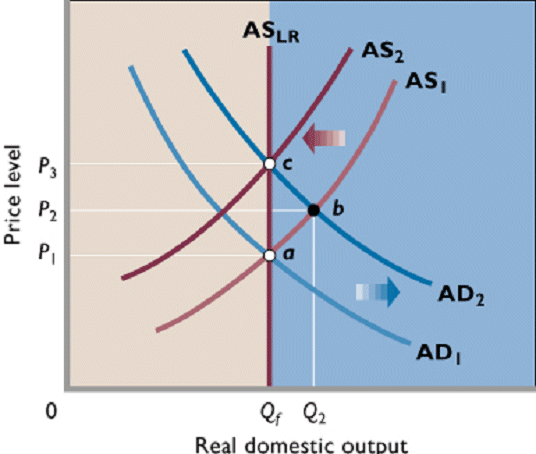
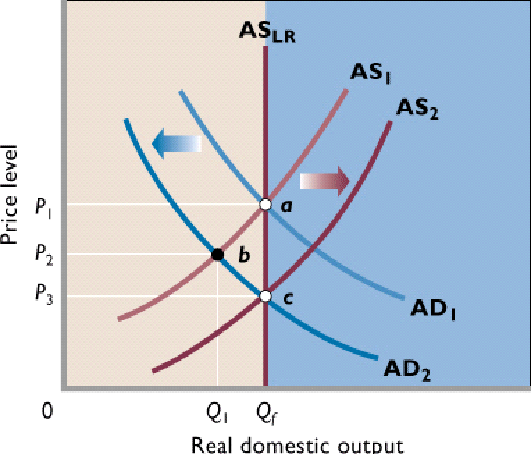
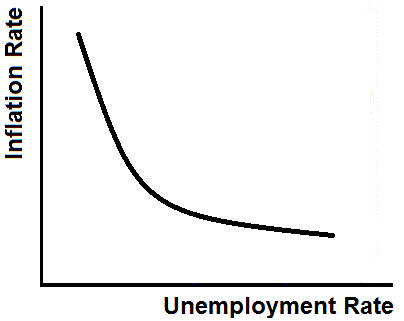
12c Review
Videos
[YouTube ACDC Leadership]
[1:50 to end YouTube ACDC
Leadership]
[3:15 to end YouTube ACDC
Leadership]
|
9a Introduction |
|
Most economists will say that the U.S. economy achieves full employment at an UE rate of about 5%. Five percent unemployment in the U.S. is about eight million people unemployed and THAT is called full employment. How can 8 million unemployed people be called "full employment"? How is the unemployment rate calculated? Who is employed? Who is unemployed? What is "full" employment? What is "unemployment"? We will try to understand the answers to these questions by returning to the 5Es of economics from lesson 1b. We learned there that the 5 Es were five ways to reduce scarcity and achieve the maximum level of satisfaction for a society. In the U.S. we can produce the maximum amount of output when there is about 5% unemployment. Confusing? Yes. It should be - - - now, but after studing this lesson it will be much more clear. |
9a Something Interesting - Why are we studying this? |
|
205,000 jobs created in March, 2016, but the unemployment rate increases. WHY?. "The American economy continues its march upward. The monthly jobs report released Friday by the Bureau of Labor Statistics showed that the economy created 215,000 jobs in March, slightly higher than the 205,000 expected. The unemployment rate ticked up to 5 percent from 4.9 percent. U.S. job growth has continued for a record 73 months in a row." How can there be both more jobs and more unemployment ? This news article linked below also says: "the increase in the unemployment rate is actually a good thing". How can that be? Read the first five paragraphs of the article linked below to find out. http://www.huffingtonpost.com/entry/march-jobs-report_us_56fe6c5de4b0a06d58056916 Most economists will say that when the U.S. economy achieves an UE rate of about 5%, then we have achieved full employment. Five percent unemployment in the U.S. is about eight million people unemployed and THAT is full employment. How can that be? Who is counted when they calculate the unemployment rate? And who is not counted? Watch the short YouTube video linked below. The Unemployment Game Show: Are You *Really* Unemployed? from Mint.com 2:10 |
9a Assignments: Readings |
|
Chapter 9: pp. 173-179 Ch. 7: "GDP Price Index," pp. 141-142 |
9a Assignments: Video Lectures |
|
11.2.1 Measuring the Labor Force and Unemployment 5:48 [MyNotes] The Unemployment Game Show: Are You *Really* Unemployed? from Mint.com 2:10 11.2.2 Types of Unemployment 4:18 [MyNotes] 11.3.1 Understanding the Natural Rate of Unemployment 4:05 [MyNotes] |
9a Outcomes - What you should learn |
|
TOPICS
OUTCOMES
|
9a Key Terms |
|
Key Terms Flash Cards - Click Here Key Terms: unemployment rate, unemployed, employed, labor force, underemployed, discouraged worker, "natural rate of UE" or "full employment rate of UE", "real rate of UE", frictional UE, structural UE, cyclical UE, potential output, GDP gap, labor force participation rate |
9a Practice Quiz (under construction) |
9a Formulas |
|
Unemployment Rate = (# UE / # labor force) x 100 |
9a Key Graphs |
|
Point D represents unemployment (or productive inefficiency) AS/AD Graph representing an economy with unemployment |
9a Review Videos |
|
- Macro
2.3- Unemployment and Natural Rate of Unemployment-
AP Macro - Unemployment
Game Show - Are you Officially
Unemployed? NOTE: These are REVIEW videos only. In order to learn the material you must read the assigned textbook readings, watch the assigned lecture videos, and do problems. See the LESSONS link on Blackboard for these assignments. |
The THREE ISSUES of
Macroeconomics are: UE, IN, and EG. In chapter 12
we learned a tool (the AS/AD model) that helped us
understand what causes UE, IN, and EG. Chapter 9
discusses the issues of UE and IN in greater
detail. And in chapters 7, 8 and 22W we study
EG. We have already learned two
causes of inflation (lesson 12b), demand-pull and
cost-push inflation, but we really did not define
inflation. Inflation (IN) is the rate of increase
in the price level, i.e. how fast it is increasing.
Here we will learn how the price level is measured
by using a price index, how inflation is
calculated, and the economic effects of
inflation. Read the short 2013 news
article below about the effects of inflation on the
minimum wage. The
Real Minimum Wage Falls Every Year — Here's
How To Fix That After reading the article you
should be wondering "What causes inflation and what
can be done about it?". After studying this lesson
you should have a better answer to that
question. OPTIONAL, but interesting:
http://www.huffingtonpost.com/2013/02/13/minimum-wage-productivity_n_2680639.html Chapter 9: pp.
179-187 p. 247 "disinflation" at the
bottom of the first column Ch. 7: "GDP Price Index," pp.
141-142 Ch. 14: "Money and Prices"
and "Stabilizing Money's Purchasing Power", pp.
285-286 11.5.1 Inflation,
Deflation, Stagflation, and
Hyperinflation 4:54
[MyNotes] 10.3.1 Changes
in the Cost of Living and the
CPI 4:47
[MyNotes] 10.3.2 Calculating
the Rate of Inflation
7:33 [MyNotes] 10.3.3 Comparing
the CPI and the GDP Deflator
6:02 [MyNotes] 11.5.2 Inflation
and Purchasing Power
7:45 [MyNotes] 11.5.3 Short-Run
Causes: Demand-Pull and Cost-Push
Inflation 9:59
[MyNotes] 11.5.5 The
Costs of Inflation
9:23 [MyNotes] 11.5.6 Case
Study: Behavior during
Hyperinflation 6:14
[MyNotes] TOPICS OUTCOMES Key
Terms Flash Cards - Click Here Key Terms: To measure inflation,
subtract last year's price index from this year's
price index and divide by last year's index; then
multiply by 100 to express as a percentage.
Demand-Pull
Inflation Cost-Push
Inflation - Inflation-
Cost-push & Demand-pull- Macro 3.6
NOTE: These are REVIEW videos
only. In order to learn the material you must read
the assigned textbook readings, watch the assigned
lecture videos, and do problems. See the LESSONS
link on Blackboard for these assignments.
![]()
9b Introduction
9b Something Interesting -
Why are we studying this?
9b Assignments:
Readings
9b Assignments: Video
Lectures
9b Outcomes - What you
should learn
9b Key Terms
inflation, inflation
rate, deflation, disinflation, price index, CPI,
purchasing power, rule of 70, cost-push
inflation, demand-pull inflation, redistributive
effects, output effects, hyperinflation, nominal
income, real income, COLAs, menu costs
9b Practice Quiz (under
construction)
9b Formulas

Inflation Rate =
[ (Price Index this year - Price Index last
year) / Price Index last year ] x 100
IN rate 2015 = [ (PI 2015 - PI 2014) / PI
2014 ] x 100
9b Key Graphs
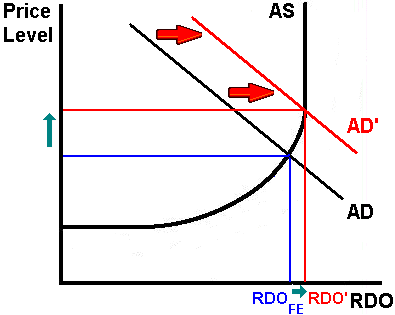
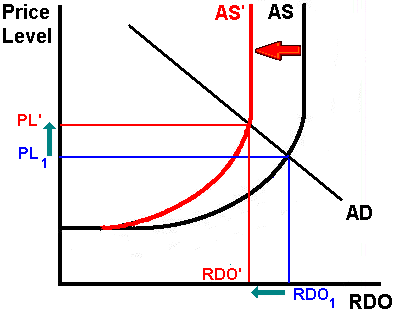
9b Review Videos
[5:35 YouTube ACDC
Leadership]
Now we begin a three chapter
(7, 8, and 22W) discussion
of economic growth (EG). Defining EG can be a little
complicated and we will study that in the next
chapter, but EG usually means "an increase in real
domestic output (RDO)". In chapter 7 we learn how
real domestic output (RDO) is measured. We have been using the AS/AD
model for several lessons now but we do not know
what numbers actually go on the axes of the graph.
What numbers do we use to measure RDO on the
horizontal axis of the AS/AD graph.? Well, we use
real GDP to measure RDO and here we learn
how it is calculated. In lesson 9b we learned how a
price index (CPI or GDP Index) measures the price
level. We use price index numbers on the vertical
axis of the AS/AD graph. Watch this short four minute
video from MRuniversity.com But how is GDP measured?
Study this lesson to find out. Chapter 7 -
ALL AGGREGATE OUTPUT AND
INCOME REVIEW (2a): 10.1.2
The
Circular Flow Model
9:38 [MyNotes] 10.1.3 Real
GDP 12:01
[MyNotes] 10.1.4 The
BEA Procedure for Calculating Real
GDP 8:15
[MyNotes] 10.1.5 Limitations
of GDP and Alternative
Indexes 4:51
[MyNotes] APPROACHES TO CALCULATING
GDP 10.2.2 The
Income Approach
7:02 [MyNotes] EconMovies-
Episode 6: Back to the Future (Nominal vs. Real,
Unemployment, Inflation)
(6:29) TOPICS OUTCOMES Key
Terms Flash Cards - Click Here Key Terms: GDP = C + Ig + G +
Xn NI = wages + rents + interest
+ corporate profits + proprietor's
income NDP = C + In + G + Xn
NDP = GDP -
depreciation In = Ig -
depreciation Xn = X - M real GDP = (nominal GDP /
price index) x 100 Circular Flow
Model - Macro
Unit 2.1- GDP and Economic Growth NOTE: These are REVIEW videos
only. In order to learn the material you must read
the assigned textbook readings, watch the assigned
lecture videos, and do problems. See the LESSONS
link on Blackboard for these assignments.
![]()
7a Introduction
7a Something Interesting -
Why are we studying this?
7a Assignments:
Readings
7a Assignments: Video
Lectures
REVIEW (1d): 10.1.1
The
Production Possibilities Frontier: Macroeconomic
Applications 18:18
[MyNotes]
10.2.1
The
Expenditures Approach
4:54 [MyNotes]
7a Outcomes - What you
should learn
7a Key Terms
Gross Domestic
Product (GDP), intermediate goods, final goods,
double counting (multiple counting), non-market
transactions, underground economy, GDP per
capita, expenditures approach, income approach,
national income (NI), proprietor's income,
personal income (PI), disposable income (DI),
nominal GDP, real GDP, gross private domestic
investment, net private domestic investment, net
domestic product (NDP), net exports
7a Practice Quiz (under
construction)
7a Formulas
7a Key Graphs

7a Review Videos
[3:37 YouTube ACDC
Leadership]
In chapter 8 the textbook
says that there are TWO DEFINITIONS of EG, but in
chapter 1 (Lessons 1b and 1c) we learned another
definition. So actually there are THREE DEFINITIONS
of EG. I believe the best way of
understanding the difference between them is to
discuss whether the growth is ACHIEVING THE
POTENTIAL of the economy or INCREASING THE
POTENTIAL of the economy. Both of these increase
RDO (real domestic output) and it is an increase in
RDO that is the COMMON DEFINITION of EG. But this
everyday definition of economic growth, the one you
hear on the news broadcasts, doesn't tell us if the
economy is achieving its potential by
producing more OR whether the economy is has
increased it potential and therefore is ABLE
to produce more. Why is this distinction
important? Why do we care? Well, there are
different CAUSES and POLICIES for each approach to
growth and both approaches increase output and
therefore reduce scarcity and increase society's
satisfaction. As we should remember from lesson 1b,
reducing scarcity and increasing society's
satisfaction is the goal of economics. The economic growth that we
are used to, 1%, 2,% 3%, 4%, maybe even, 7%, 8% or
even 9% a year, is a recent phenomonon in the
history of the world. Prior to the beginning of the
17th century, (arouind 1800) all parts of the world
had similar living standards and these living
standards had not changed much for thousands of
years. See graph below. Now we expect long term
economic growth and livuing standards in different
parts of the world very significantly. Why? We will study this and
other econmic growth issues in this
lesson. Chapter 8 -
ALL Ch. 1 "A Growing
Economy" and "Present Choices and Future
Possibilities", pp. 15-18 16.1.2 The
PPF, the AD/AS Model, and Long-Run
Growth 7:44
[MyNotes] 16.1.3 The
Production Function and
Growth 6:49
[MyNotes] 16.1.4 The
Definition of Productivity and Factors Affecting
It 3:54
[MyNotes] TOPICS OUTCOMES Key
Terms Flash Cards - Click Here Key Terms: GDP per capita = GDP /
population Modern Economic
Growth Economic Growth and the
5Es: EG - INCREASING THE
POTENTIAL EG - ACHIEVING THE
POTENTIAL EG - ACHIEVING THE
POTENTIAL EG - INCREASING THE
POTENTIAL EG - INCREASING THE
POTENTIAL - Economic
Growth and LRAS- Macro 3.14 NOTE: These are REVIEW videos
only. In order to learn the material you must read
the assigned textbook readings, watch the assigned
lecture videos, and do problems. See the LESSONS
link on Blackboard for these assignments.
![]()
8a Introduction
8a Something Interesting -
Why are we studying this?
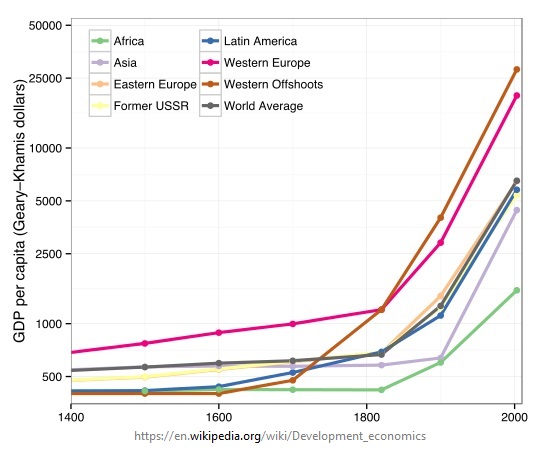
8a Assignments:
Readings
8a Assignments: Video
Lectures
8a Outcomes - What you
should learn
8a Key Terms
economic growth,
increasing the potential, achieving the
potential, GDP per capita, rule of 70,
productivity, production, productive efficiency,
modern economic growth, the great divergence,
leader countries, follower countries, property
rights, patents and copyrights, simultaneous
consumption, network effects, labor force
participation, infrastructure, human capital,
economies of scale
8a Practice Quiz (under
construction)
8a Formulas
8a Key Graphs

Economic Growth is
"Increasing the Potential"
Prod. Eff. and Full Emp[loyment is
"Achieving the Potential.
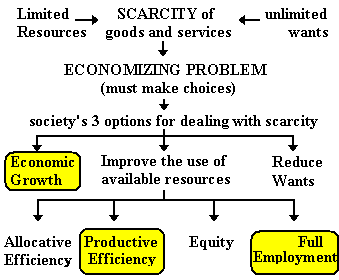
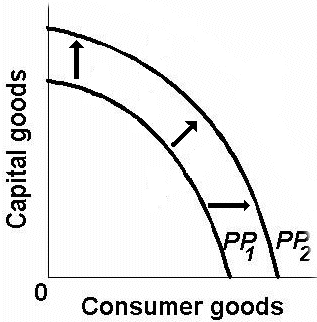

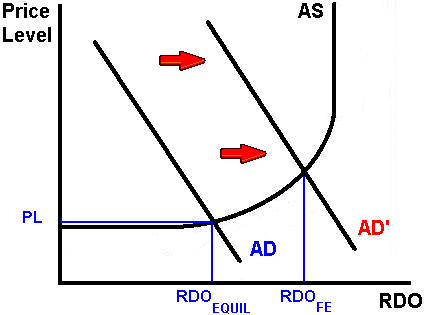

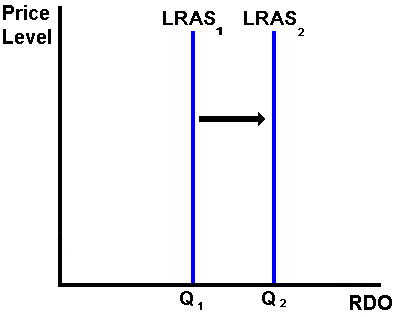
8a Review Videos
[2:58 YouTube ACDC Leadership]
- 925 million people do
not have enough to eat - more than the combined
populations of the USA, Canada, and the European
Union; (Source: FAO news release, 14 September
2010) - Nearly half the
world’s population, 2.8 billion people,
survive on less than $2 a day. - About 20 percent of the
world’s population, 1.2 billion people,
live on less than $1 a day. - Nearly 1 billion people
are illiterate and 1 billion do not have safe
water. - 98 percent of the
world's hungry live in developing countries;
(Source: FAO news release, 2010) Source: I believe that no discussion
of EG is complete without a discussion of the
world's poor where EG means more than getting a new
car or another vacation -- it is a matter of life
and death. A discussion of the world's
less developed countries also allows us to return
to the subject of STRUCTURAL ADJUSTMENT
(globalization) that we studied in unit 1. This
would be a good time to review your notes from
lesson 2a. Because of the economic growth that has
resulted from Structural Adjustment in the past few
decades, millions of people in the less developed
countries have been lifted out of poverty.
The figure below shows the
great decline in the number of people living on
$1.25 a day or less since 1990. From: Oxfam
report highlights widening income gap between
rich, poor 85 people's wealth =
3,500,000,000 people's wealth. And, the gap between the rich
and the poor is widening. Think about it. In this
lesson we will begin to understand why. Chapter 22W - ALL
- found at: Chapter
22w Also read:
Measures
of EconomicDevelopment Oxfam
report highlights widening income gap between rich,
poor 16.3.1 Growth
in Emerging Economies
10:23 [MyNotes] 10.1.6 The
Growth of China as a
Superpower 2:14
[MyNotes] 16.3.2 Policies
to Promote Growth
7:50 [MyNotes] 16.2.2 Other
Policies to Encourage Growth
10:40 [MyNotes] 16.3.3 Hot
Topic: The Myth of Exploding
Populations 8:00
[MyNotes] 16.2.3 Hot
Topic: Women's Roles in Rural Economic
Growth 4:59
[MyNotes] TOPICS OUTCOMES Key
Terms Flash Cards - Click Here Key Terms: Income per capita: Low,
Middle, and High Income Countries The True Size of the
Continents (yellow) and the Size Seen on Many Maps
(black outline) - Economic
Growth in the Less Developed
Countries NOTE: These are REVIEW videos
only. In order to learn the material you must read
the assigned textbook readings, watch the assigned
lecture videos, and do problems. See the LESSONS
link on Blackboard for these assignments.
![]()
22Wa
Introduction
From the United
Nations:
http://www.un.org/en/globalissues/briefingpapers/food/vitalstats.shtml
22Wa Something Interesting -
Why are we studying this?
"The 85 richest
people on Earth now have the same amount of
wealth as the bottom half of the global
population, according to a report released
Monday by the British humanitarian group Oxfam
International."
22Wa Assignments:
Readings
22Wa Assignments: Video
Lectures
22Wa Outcomes - What you
should learn
22Wa Key Terms
LDCs (DVCs), MDCs
(IACs), global south, primary activities,
secondary activities, tertiary activities,
vicious circle of poverty, brain drain, land
reform, microfinance and Grameen Bank, World
Bank, foreign direct investment, GDP per capita,
capital flight, supply chain, Malthus, green
revolution, financial intermediary
22Wa Practice Quiz (under
construction)
22Wa Key Graphs /
Figures
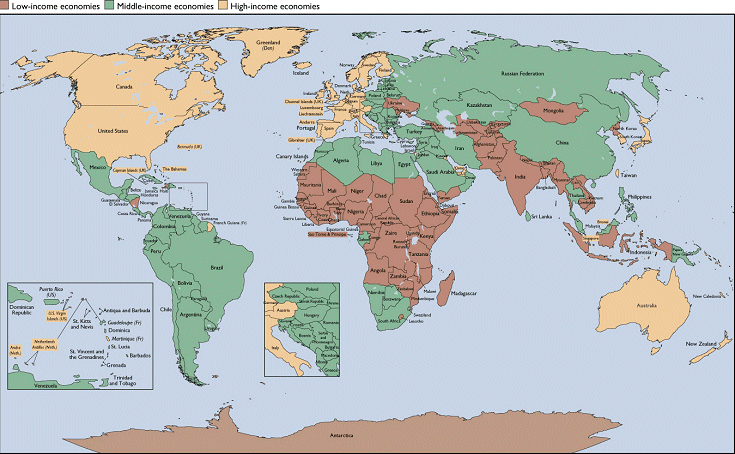
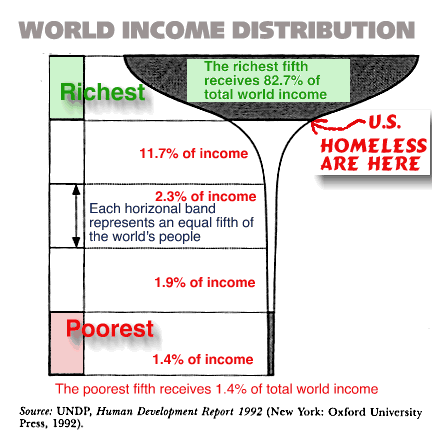
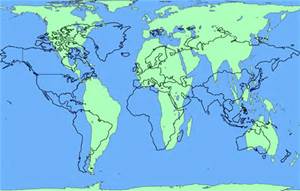
22Wa Review
Videos
[9:45 YouTube Brad Cartwright
Economics]
We now begin unit 3
where we focus on macroeconomic POLICY. When we say
"policy" we mean "government". What can the
government do to achieve the three macroeconomic
goals of low UE, low IN, and rapid EG? In lesson
12c we introduced stabilization policies: monetary
policy and fiscal policy. (This would be a good
time to review your notes on lesson 12c.) Here, we
will dig deeper, beginning with Monetary Policy
(MP). In lesson 12 c we learned
that if UE is high we can increase the money supply
(MS) which will cause interest rates to go down. We
called this an "Easy Money Policy". Lower interest
rates will increase investment (I) and therefore
increase aggregate demand (AD). When AD increases
it will increase real domestic output (RDO or real
GDP) and decrease UE. But, it may increase the
price level (PL) and therefore increase
inflation. Easy (Expansionary)
MP: Tight (Contractionary)
MP: We begin monetary policy in
lesson 14a by defining money (what is money?) and
the money supply (MS). Then we will develop the
model of the money market that we will use in the
next three chapters to show how monetary policy
works. We finish the lesson with a discussion of
the structure of the Federal Reserve (the Fed). As
we know from lesson 12a the Fed controls the money
supply (MS). Here we learn that "the Fed" is
NOT the federal government in Washington DC.
The policy making arm of the
Fed is basically the Federal Open Market Committee
(FOMC) comprised of 12 people and these 12 people
have the power to raise interest rates and put
millions of people of work as they did in the early
1980s. Or, the FOMC can lower interest rates
causing millions of people to earn less on their
financial investments. The chairperson of the Fed
(Janet Yellen in 2016) has been called "the second
most powerful person in the United States". In this
unit we will learn why. Listen or read the link
below. Banks printed their own
paper money. And, unlike today, a $1 bill wasn't
always worth $1. Sometimes people took the bills
at face value. Sometimes they accepted them at a
discount (a $1 bill might only be worth 90
cents, say). Sometimes people rejected certain
bills altogether. Pictures of early
money: So, WHAT IS MONEY? Study this
lesson for the answer. Chapter 14: ALL Chapter 16: Interest Rates
(pp. 315-317) and Cause-Effect Chain (pp.
329-330) Read Paper
3 Instructions and
start looking for your news article Planet Money Episode
421: The Birth Of The Dollar
Bill (10:37). Audio
only. Interesting radio story on early money in the
US. Pictures of early
money: 13.1.1 The
Money Supply 8:10
[MyNotes] 13.4.2 Case
Study: Cigarettes As Money
6:07 [MyNotes] 13.1.2 Determinants
of Money Demand 9:00
[MyNotes] 13.1.3 The
Money Market 10:02
[MyNotes] Money
Market - Macro Review
3:24 [YouTube ACDCLeadership] 13.3.1 The
Federal Reserve System
8:13 [MyNotes] TOPICS OUTCOMES Key
Terms Flash Cards - Click Here Key Terms: Money Demand Money Market Increase in the Money
Supply Decrease in the Money
Supply - Macro
4.2- Functions of Money - The
Money Market- Macroeconomics 4.6
- Macro
4.5- The Federal Reserve System- Quick
Overview NOTE: These are REVIEW videos
only. In order to learn the material you must read
the assigned textbook readings, watch the assigned
lecture videos, and do problems. See the LESSONS
link on Blackboard for these assignments.
![]()
14a Introduction


14a Something Interesting -
Why are we studying this?
Planet Money Episode
421: The Birth Of The Dollar
Bill
(10:37).Before the Civil
War, there were 8,000 different kinds of money
in the United States.
Pre-Civil
War Bank Note
14a Assignments:
Readings
- Pre-Civil
War Bank Note
14a Assignments: Video
Lectures
14a Outcomes - What you
should learn
14a Key Terms
barter, coincidence
of wants, money, medium of exchange, unit of
account, store of value, commodity money, near
money, liquidity, M1, M2, money supply (MS),
federal reserve notes, checkable deposits, money
demand (total money demand), transactions
demand, asset demand, money market model,
Federal Reserve System, Board of Governors, FOMC
14a Practice Quiz (under
construction)
14a Key Graphs
- D1 is Transactions Demand
- D2 is Asset Demand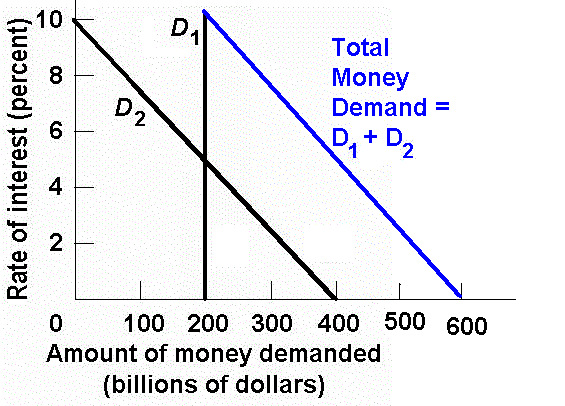
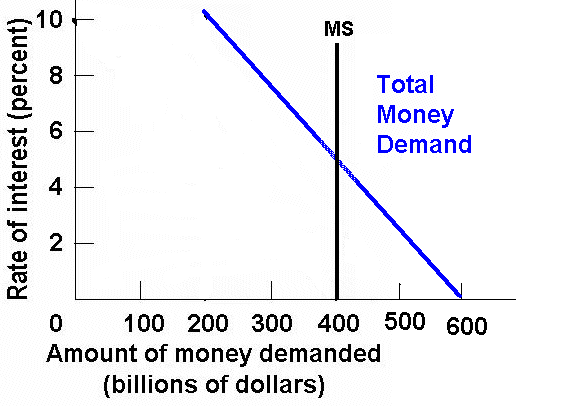
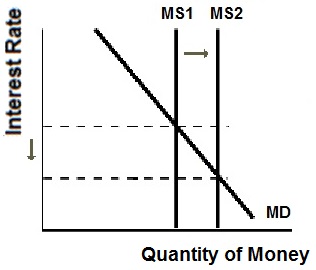
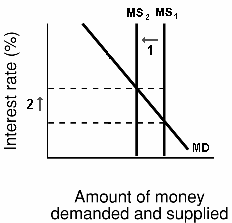
14a Review
Videos
[2:01 YouTube ACDC
Leadership]
[3:24 YouTube ACDC Leadership]
[1:59 YouTube ACDC Leadership]
Most students are very
surprised when they learn that when banks make
loans they create money. Yes, banks create money
whenever they make a loan. If I get a loan from a
bank to buy a new boat, the money I get has been
CREATED by the bank. The US government does not
create money. The Federal Reserve does not create
money. BANKS CREATE MONEY. BUT, the Fed can control
how much money banks can create. We will learn how
the Fed does this in the next lesson (16a). Here we
learn HOW BANKS CREATE MONEY Watch this short clip from
the Christmas movie It's a Wonderful
Life: Then read the first two short
sections on the webpage linked below: "Definition
of a Bank Run" and "How Banks Work: Demand
Deposits" (only 8 short paragraphs). You may have
to tap "Show Full Article" to see "How Banks
Work: Demand Deposits" After studying this lesson
you should understand how bank runs may
occur. Chapter 15:
ALL 13.4.1 How
Goldsmiths Created Money
7:40 [MyNotes] How
banks create money and the money
multiplier 4:12
[YouTube ACDCLeadership] 13.4.3 How
Banks Create Money
12:09 [MyNotes] TOPICS OUTCOMES Key
Terms Flash Cards - Click Here Key Terms: Total Change in Money Supply
= Initial excess reserves x Money
Multiplier Total Reserves = Cash in
vault + Deposits at Fed Required Reserves = Reserve
Requirement x Liabilities Excess Reserves = Total
Reserves - Required Reserves Money Multiplier = 1 /
Reserve Requirement Balance Sheet of
Banks - How
Banks Create Money and the Money Multiplier- Macro
4.8 NOTE: These are REVIEW videos
only. In order to learn the material you must read
the assigned textbook readings, watch the assigned
lecture videos, and do problems. See the LESSONS
link on Blackboard for these assignments.
![]()
15a Introduction
15a Something Interesting -
Why are we studying this?
Watch this short clip from
the Christmas movie It's a Wonderful
Life:
It's
a Wonderful Life Bank Run
What
is a Bank Run?
15a Assignments:
Readings
15a Assignments: Video
Lectures
15a Outcomes - What you
should learn
15a Key Terms
fractional reserve
banking system, goldsmith banking, balance sheet
(T-account), assets, liabilities, assets of a
commercial bank, liabilities of a commercial
bank, reserves (total reserves or actual
reserves), reserve ratio, required reserves,
excess reserves (lendable reserves), demand
deposit, check clearing, money multiplier
(deposit expansion multiplier, monetary
multiplier), government securities or bonds, net
worth (owner's equity), run on a bank (bank run)
15a Practice Quiz (under
construction)
15a Formulas
15a Key Graphs
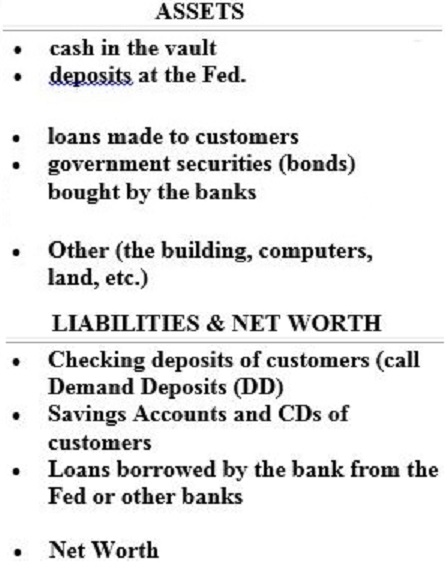
15a Review
Videos
[4:11 YouTube ACDC
Leadership]
Get this right: THE FED DOES
NOT SET INTEREST RATES. I know you will read in the
news that the "Fed has increased interest rates".
But the Fed does NOT change interest rates. Banks
set their own interest rates, BUT the Fed can cause
banks to raise or lower their rates. Also, the Fed does not change
the money supply (MS). As we learned in the
previous lesson (15a) banks create money and
therefore banks change the money supply, NOT THE
FED. But you may ask, didn't we say in lesson 12c
that the Fed changes the MS? Yes we did, but we
didn't say how they do it. We will do that
here. We will learn that the Fed
has three tools to control the MS: open market
operations (OMO), the discount rate (DR), and the
required reserve ratio (RR). The Fed uses these
three tools to change the excess reserves (ER) of
banks. And, as we learned in the previous lesson
(15a) if banks have more ER they can make more
loans and increase the money supply (MS) and if
banks have fewer ER they make less loans and
decrease the MS. Finally, as we learned in
lesson 12c, when the MS changes this causes
interest rates to change. When interest rates
change then this causes Investment (I) to change
(and also consumption [C]). When Investment
(I) changes it causes aggregate demand (AD) to
change. When AD changes it causes a change in the
price level (PL) and real domestic output (RDO).
When the PL changes it causes a change in inflation
(IN) and when RDO changes it causes a change in
unemployment (UE) and economic growth
(EG). To understand how monetary
policy (MP) works you need to get the CAUSE and
EFFECT order correct. What CAUSES what? The
" Memorize the following.
Practice writing it until you get it
correct. Listen to the first minute
and ten seconds of the podcast below. (The first
two minutes are NOT about basketball in Cuba.)
Click on "Listen to this story". PODCAST:
Basketball heads to Cuba After studying this lesson
you should be able to use a series of three
graphs GRAPHS to explain this podcast. You
should be able to explain what is happening in
China and how they hope it will affect
unemployment, inflation, and economic
growth. Chapter 10 pp.
199-204 Chapter 16 pp. 317-323;
324-336 13.3.3 The
Fed's Tools of Monetary
Policy 9:46
[MyNotes] 13.4.4 How
the Fed Changes the Money
Supply 10:06
[MyNotes] AC Macro
4.1- Money Market and FED Tools (Monetary
Policy) 5:20
[YouTube ACDCLeadership]
[MyNotes] AC Macro
4.9- Monetary Policy
Practice 3:21
(recessionary gap) [YouTube
ACDCLeadership] AC Macro
4.10- Graphing Monetary Policy Practice (AP
Macroeconomics) 2:44
(inflationary gap) [YouTube
ACDCLeadership] 15.4.3 Monetary
Responses to Changes in the
Economy 12:20
[MyNotes] OPTIONAL 13.3.4
Case
Study: The Greenspan Era
3:16 [MyNotes] TOPICS OUTCOMES Open Market Operations
(OMO) Required Reserve Ratio
(RR) Discount Rate (DR) Key
Terms Flash Cards - Click Here Key Terms: - Money
Supply Shifters- Macroeconomics 4.7 - Macro
4.9- Monetary Policy
Practice (Reduce
UE) - Macro
4.10- Graphing Monetary Policy Practice (AP
Macroeconomics)
(Reduce IN) - Macro
4.11- Money Multiplier & Reserve Requirement
(AP Macro) - Macro
4.12- Money Multiplier Practice (AP
Macro) NOTE: These are REVIEW videos
only. In order to learn the material you must read
the assigned textbook readings, watch the assigned
lecture videos, and do problems. See the LESSONS
link on Blackboard for these assignments.
![]()
16a Introduction
![]() "
symbol below means CAUSES. Notice that is an arrow
pointing only in one direction meaning that what
comes before CAUSES what comes after. For example:
not studying
"
symbol below means CAUSES. Notice that is an arrow
pointing only in one direction meaning that what
comes before CAUSES what comes after. For example:
not studying ![]() lower grades.
lower grades. 
16a Something Interesting -
Why are we studying this?
16a Assignments:
Readings
16a Assignments: Video
Lectures
16a Outcomes - What you
should learn
http://www.marketplace.org/topics/economy/podcast-basketball-heads-cuba
Tools of Monetary
Policy
Buy securities
![]()
![]() ER
ER ![]()
![]() MS
MS
Sell securities ![]()
![]() ER
ER ![]()
![]() MS
MS![]() RR
RR
![]()
![]() ER
ER ![]()
![]() MS
MS
![]() RR
RR ![]()
![]() ER
ER ![]()
![]() MS
MS![]() DR
DR
![]()
![]() ER
ER ![]()
![]() MS
MS
![]() DR
DR ![]()
![]() ER
ER ![]()
![]() MS
MS
16a Key Terms
expected rate of
return, investment demand, assets of the Federal
Reserve banks, liabilities of the Federal
Reserve banks,
Federal Reserve notes, Open Market Operations
(OMO), Discount Rate (DR), Required Reserve
Ratio (RR), Federal funds rate (Fed
funds)
16a Practice Quiz (under
construction)
16a Key Graphs




16a Review
Videos
[2:44 YouTube ACDC
Leadership]
[3:20 YouTube ACDC Leadership]
[2:44 YouTube ACDC Leadership]
[2:43 YouTube ACDC Leadership]
[3:02 YouTube ACDC Leadership]
Now that we know how monetary
policy (MP) works we will examine other issues
associated with it. Economists disagree over the
effectiveness and efficacy of monetary policy.
Mainstream (New Keynesian) economists believe
monetary policy is not very effective but it should
be used to accommodate fiscal policy. Monetarists
(New Classical) economists believe monetary policy
is very effective but should not be used with
discretion. Read those two sentences
again. Mainstream/New
Keynesian economists believe MP IS NOT
EFFECTIVE BUT IT SHOULD BE USED. Monetarist/New
Classical economists believe MP IS VERY
EFFECTIVE BUT DON'T USE IT. Isn't economics
fun? From our textbook, p.
361: In this lesson we discuss why
economists thought that the economy would achieve
full employment in the long run and what Keynes
meant when he said "In the long run we are all
dead". Chapter 13: Problems of
timing p.267 Chapter 16:
332-337 Chapter 19: 381-384,
386-392 OPTIONAL 11.1.2
Theoretical
Explanations for Cycles
10:09 [MyNotes] 11.5.4 The
Quantity Theory of Money
11:58 [MyNotes] 15.5.1 New
Keynesians versus
Monetarists 11:23
[MyNotes] 15.5.2 New
Classical Macroeconomics
8:31 [MyNotes] 15.5.3 Case
Study: Policy in the Great
Depression 8:22
[MyNotes] 15.4.5 Hot
Topic: Should Monetary Policy Be Made by Rule or
Discretion? 5:03
[MyNotes] MJM 25 Macroeconomic
Viewpoints 7:06
[YouTube mjmfoodie] [MyNotes] TOPICS OUTCOMES Key
Terms Flash Cards - Click Here Key Terms: MV = PQ Long Run Adjustment to a
decrease in AD Long Run Adjustment to a
decrease in AD Macro
3.8- Classical vs. Keynesian Aggregate Supply-
Macroeconomics NOTE: These are REVIEW videos
only. In order to learn the material you must read
the assigned textbook readings, watch the assigned
lecture videos, and do problems. See the LESSONS
link on Blackboard for these assignments.
![]()
16b Introduction
16b Something Interesting -
Why are we studying this?
"During the early
years of the Great Depression, many economists
suggested that the economy would correct itself
in the long run without government intervention.
To this line of thinking, economist John Maynard
Keynes remarked, “In the long run we are
all dead!”"
16b Assignments:
Readings
16b Assignments: Video
Lectures
Does the economy self-adjust? If so, what is the
role for the government if the economy is not where
we'd like it to be? This video takes a brief look
at two different schools of economic
thought.
16b Outcomes - What you
should learn
16b Key Terms
recognition lag,
administrative lag, operational lag, cyclical
asymmetry, liquidity trap, equation of exchange,
velocity of money, new classical economics
(monetarism), mainstream economics (Keynesian ),
efficiency wage, monetary rule, inflation
targeting
16b Practice Quiz (under
construction)
16b Formulas
M = money supply
V = velocity of money
P = price level
Q = real GDP
PQ = nominal GDP
16b Key Graphs
(from a to b to c)
(from a to b to c)
16b Review
Videos
[4:29 YouTube ACDC
Leadership]
The final two chapters look
at fiscal policy (FP). We studied fiscal policy in
lesson 12c. There we learned that if we have high
unemployment (UE) the government can increase
government spending (G) or cut taxes (T) to reduce
it. If there is high inflation (IN) then the
federal government can decrease spending or
increase taxes to reduce it. "HOW MUCH". That is how
chapter 10 differs from chapter 12. In chapter 12
we learned that if government spending (G)
increases it will cause an increase in AD which
will cause an increase in output (RDO) and help
reduce UE. But, HOW MUCH will output increase? In
chapter 12 we learned that if taxes increase it
will cause a decrease in AD which will cause a
decrease in output (RDO) and reduce IN. But, HOW
MUCH will output decrease? We will learn that if
government spending increases by let's say $10
billion, then real GDP (RDO) will increase by MUCH
MORE than $10. This is called the "multiplier
effect". Sounds like magic, but you will soon
understand why. We know that GDP = C + Ig + G
+ Xn. If when the economy is at
full employment GDP equals $500 billion, then
what increase in investment spending (Ig) is
needed to achieve full employment? ANSWER: Much less than
$100. In this lesson you will
learn how an increase in spending (like an
increase in investment) is MULTIPLIED as it
works its way through the economy. The muliplier can work in
reverse as well. A small decrease in spending will
cause a big decrease in GDP. Chapter 10: pp. 191-198,
204-209 Chapter 12: pp.
244-248 Good Review: 15.1.1
Recessions
and Booms Unanticipated Changes in Aggregate
Demand 12:04
[MyNotes] Good Review: 15.1.2
Recessions
and Booms Unanticipated Changes in Aggregate
Supply 15:43
[MyNotes] EC Fiscal
Policy – the Government Spending
Multiplier 20:07
[MyNotes] AC Macro
3.9- Multiplier Effect, MPC, and
MPS 2:17
[MyNotes] AC Macro
3.10- Calculating the
Multiplier 1:50
[MyNotes] AC Macro
3.11 Multiplier and Spending
Practice 2:02
[MyNotes
IMPORTANT!!!] TOPICS OUTCOMES Key
Terms Flash Cards - Click Here Key Terms: APC = C / Y MPC = APS = S / Y MPS = APC + APS = 1 MPC + MPS = 1 Simple Multiplier = 1 /
MPS The Consumption
Function The Saving
Function The Multiplier
Effect - Macro
3.9- Multiplier Effect, MPC, and MPS (AP
Macroeconomics) - The
Multiplier Effect- Macro 3.9B (Technical Tuesday)
- Macro
3.10- Calculating the Spending
Multiplier NOTE: These are REVIEW videos
only. In order to learn the material you must read
the assigned textbook readings, watch the assigned
lecture videos, and do problems. See the LESSONS
link on Blackboard for these assignments.
![]()
10a Introduction
10a Something Interesting -
Why are we studying this?
Assume GDP is
currently $400 billion:
GDP = C + Ig + G + Xn. = $400
Read:
The
Multiplier Effect (in reverse)
10a Assignments:
Readings
10a Assignments: Video
Lectures
10a Outcomes - What you
should learn
If at full employment GDP equals $500 billion,
but it is currently at $400 billion, then what
increase in investment (I) is needed to achieve
full employment? MPC = 0.8
10a Key Terms
multiplier effect,
consumption schedule, saving schedule, Average
Propensity to Consume (APC), Average Propensity
to Save (APS), Marginal Propensity to Consume
(MPC), Marginal Propensity to Save (MPS),
leakages from the income = expenditures stream,
injections into the income = expenditures
stream, simple multiplier, complex (actual)
multiplier, multiplier with changes in the price
level (inflation)
10a Practice Quiz (under
construction)
10a Formulas
![]() C /
C / ![]() Y
Y![]() S /
S / ![]() Y
Y![]() GDP
= Initial
GDP
= Initial ![]() Spending x Multiplier
Spending x Multiplier
10a Key Graphs
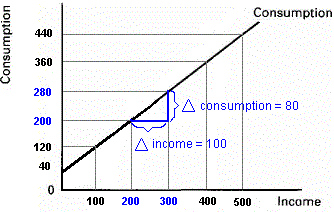
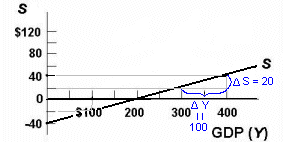
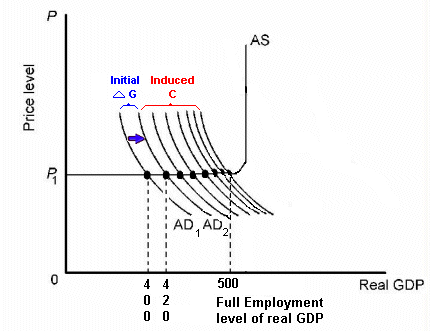
10a Review
Videos
[2:16 YouTube ACDC
Leadership]
[5:34 YouTube ACDC Leadership]
[1:49 YouTube ACDC Leadership]
|
13a Introduction |
|
In lesson 10a we just learned that a small change in spending is multiplied as it works its way through the economy and results in a larger change in total spending. Here we will focus on FISCAL POLICY (FP). What can the federal government do if there is high unemployment or high inflation, and HOW MUCH should they do? (When we say "federal government" we mean the president and congress NOT the Federal Reserve.) We know that if there is high unemployment (UE) the government can increase spending or cut taxes. Here we study HOW MUCH? We know that if there is high inflation (IN) the government can decrease spending or raise taxes, but HOW MUCH? So how effective is FP? What is the size of the multiplier? If the multiplier is large then a small change in government spending (G) and taxes (T) will have a big effect on RDO and therefore on UE and IN. If the multiplier is small than a large change in G and T will have a small effect on RDO and therefore on UE and IN. The size of the multiplier (the effectiveness of FP) depends on many different things. We will study eight different multipliers, 8 different things that affect the size of the multiplier and therefore affect the effectiveness of FP. See the list in the Yellow Pages. |
13a Something Interesting - Why are we studying this? |
|
If we increase government spending by $500 million (increases AD) AND if we increase taxes by $500 million (decreases AD) to pay for the additional spending, what will happen to real GDP (AD)? Answer: AD will increase by $100. See the "balanced-budget multiplier" in this lesson. |
13a Assignments: Readings |
|
Chapter 13 pp. 257-269 Review Ch. 18 pp. 374-378 "Taxation and Aggregate Supply" Chapter 18: pp. 374-378 |
13a Assignments: Video Lectures |
|
FISCAL POLICY: THE MAINSTREAM 15.2.1 Fiscal Policy Using the AD/AS Model 5:24 [MyNotes] FISCAL POLICY OTHER 15.2.5 Hot Topic: The Political Business Cycle 3:35 [MyNotes] |
13a Outcomes - What you should learn |
|
TOPICS
OUTCOMES
|
13a Key Terms |
|
Key Terms Flash Cards - Click Here Key Terms: fiscal policy (FP), discretionary fiscal policy, expansionary FP, contractionary FP, government spending multiplier, lump-sum tax multiplier, "balanced budget" multiplier, built-in stabilizers, tax progressivity, cyclically-adjusted (full employment or standardized) budget, cyclical deficit, crowding-out effect, multiplier with crowding out, monetary policy accommodation, supply-side FP, recognition lag, administrative lag, operational lag, political business cycle, pro-cyclical policy, counter-cyclical policy, Laffer curve |
13a Practice Quiz (under construction) |
13a Formulas |
|
Simple Multiplier = 1 / MPS tax multiplier = simple multiplier - 1 tax multiplier = MPC / MPS |
13a Key Graphs |
|
Multiplier Effect Laffer Curve |
13a Review Videos |
|
- Keynesian
Economics with Jacob
Clifford - Macro
3.7- Fiscal Policy: Non-discretionary vs
Discretionary "AP Macro" - Macro
4.14- Loanable Funds & Crowding
Out NOTE: These are REVIEW videos only. In order to learn the material you must read the assigned textbook readings, watch the assigned lecture videos, and do problems. See the LESSONS link on Blackboard for these assignments. |
We still have a few
things to discuss regarding Fiscal Policy
(FP): - Policy in the Great
Depression - New Keynesian and New
Classical FP (Does FP work?) - Government Budget Deficits
and Trade - The Federal Deficits and
Debt See: http://www.usdebtclock.org/ Should the federal government
be forced to balance its budget to help reduce the
growing $18 trillion debt? Dangers
of a Balanced Budget Amendment "A balanced budget amendment
. . . is a terrible idea. Although it sounds good
in theory, requiring Congress to balance the budget
each year would eliminate one of the most effective
means we have of ensuring that the economy works as
effectively as possible and thereby it would lower
growth, increase unemployment, and cause greater
levels of poverty and inequality." pp. 228, 310 Chapter 13: pp. 269-
275 Read again: Chapter 19: 381-384,
386-392 p. 415, "Increased Domestic
Employment Argument" The Smoot-Hawley Tariff Act of
1930 Other FP
Issues 15.3.1 New
Keynesian and New Classical Approaches to Fiscal
Policy 11:03
[MyNotes] 17.4.1 Government
Budget Deficits and Trade
5:11 [MyNotes] The Deficits and Public
Debt DEBATE - The Debt and Deficits
are Really Bad TOPICS OUTCOMES Key
Terms Flash Cards - Click Here Key Terms: New
Keynesian New
Classical US Public
Debt Macro
3.8- Classical vs. Keynesian Aggregate Supply-
Macroeconomics Fiscal
& Monetary Policy Review- AP
Macroeconomics MACROeconomics
15 Minute Review NOTE: These are REVIEW videos
only. In order to learn the material you must read
the assigned textbook readings, watch the assigned
lecture videos, and do problems. See the LESSONS
link on Blackboard for these
assignments.
![]()
13b Introduction
13b Something Interesting -
Why are we studying this?
13b Assignments:
Readings
Chapter 12:
247-248
13b Assignments: Video
Lectures
15.5.3
Case
Study: Policy in the Great
Depression 8:22
[MyNotes]
14.3.6
Case
Study: The U.S. National
Debt 8:00
[MyNotes]
- The Debt and
the Deficits are Not So Bad
Understanding
the National Debt and Budget
Deficit (6:33
YouTube vlogbrothers)
America's
Debt Crisis Explained
(5:05 youTube PragerU)
13b Outcomes - What you
should learn
13b Key Terms
New Keynesian, New
Classical, Glass-Steagall, Smoot-Hawley Tarriff
Act, U.S. Securities, public deficits, public
debt, public debt held by the public,
intragovernmental debt, external public debt,
crowding out, public investments, public-private
complementarity, efficiency wage
13b Practice Quiz (under
construction)
13b Key Graphs
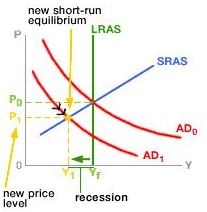
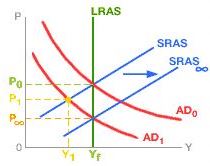
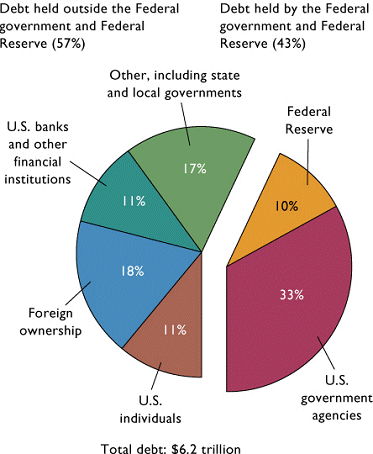
13b Review
Videos
[4:29 YouTube ACDC
Leadership]
[3:58 YouTube ACDC
Leadership]
[15:05 YouTube ACDC Leadership]